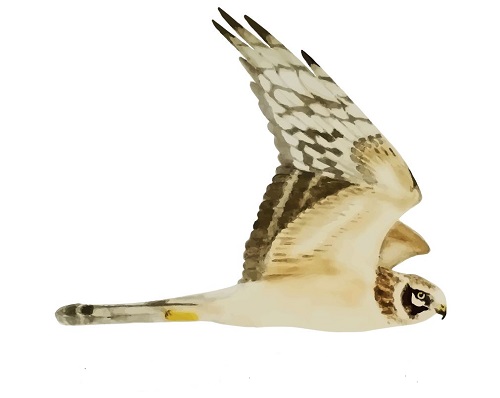Her på Skagen Fuglestations blog bringes korte nyheder i dagbogsformat om hændelser på fuglestationen.
Ringing as its best
Most of today took place at Kabeltromlen. At the same time as the ringers got up, Antonia had to leave us today to go to Blåvand, where she will be helping at the Bird Observatory for the next two months. I can speak for all of us that we will miss you very much. It was a great time and we were able to share beautiful experiences. It's amazing how much you've learned in your short time here, and I'm sure you'll be able to put it to good use and perfect it in the next two months. It started early in the morning here and we were able to ring a few birds in the first round. Especially some Wrens (Gærdesmutte) were conspicuous, as we had had considerably fewer the last few days. In the second round we had the highlight of the day - a Yellow-browed Warbler (Hvidbrynnet Løvsanger)! This is now the second and the cool thing was that this beautiful bird even had a moult limit in the greater coverts (GC), which is rarely seen in this species. This made it easy to determine the age of the bird and to see that it hatched only this year.
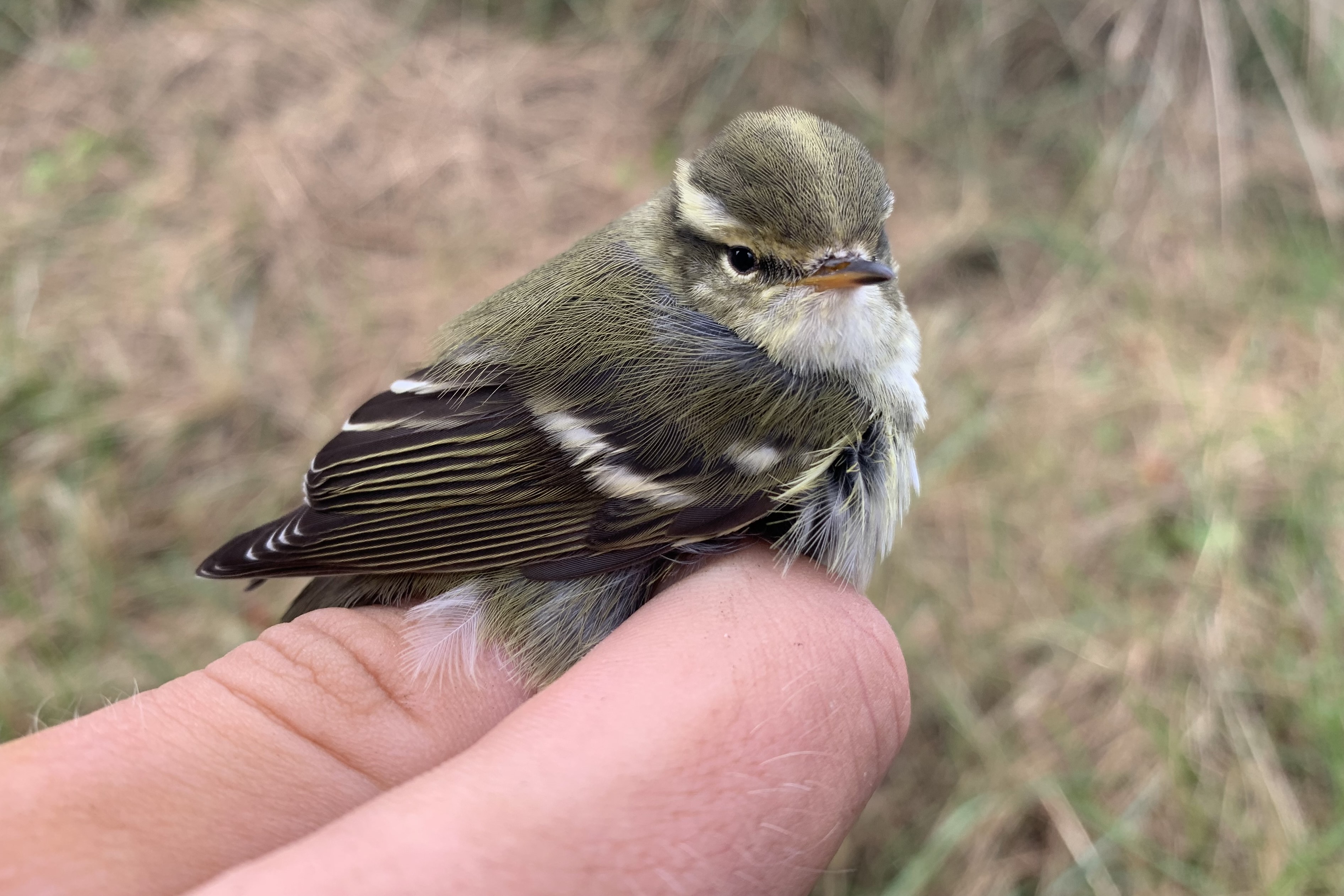
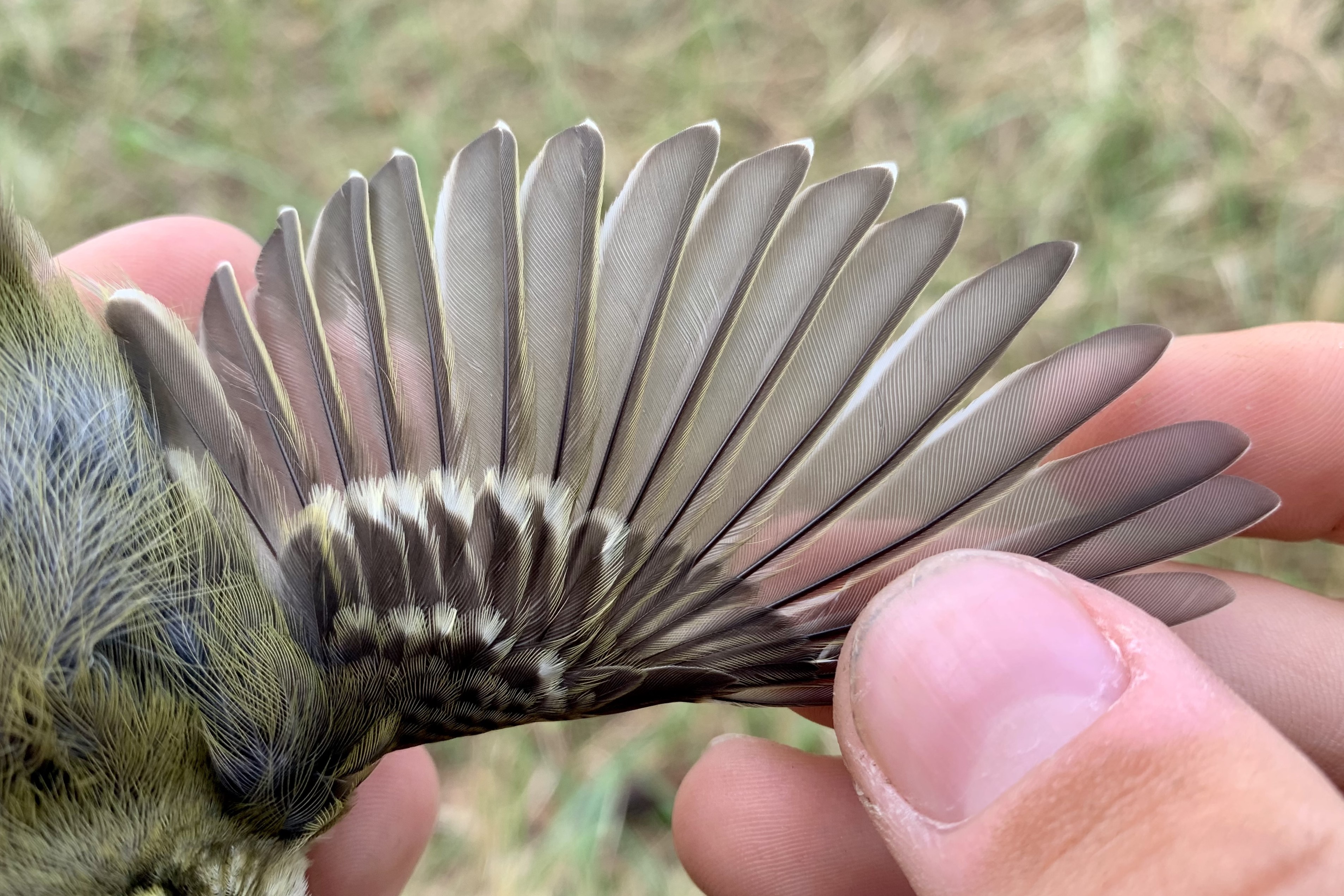
Then we caught three Lesser Redpolls (Lille Gråsisken) travelling together in a troop. And this was by far the nicest flock I have ever seen! One bird was unringed and got a Danish ring from us. But the other two already had a ring. One was ringed in Sweden, wow! But the other one pleased me even more: a ring from Germany. Just for fun I asked at home, because we had ringed some redpolls in Horumersiel, where I learned ringing in Germany. And the answer took me completely by surprise. The bird we checked today was actually ringed in Horumersiel in mid-April this year. How cool is that?
Shortly before the end of the ringing session Rebecca left, as she will also be leaving us today to return to Scotland to continue her studies. It was a lovely time with you and it was always totally great to see you getting excited about all things natural (from fungi to butterflies). Good luck with your studies and I'm sure we'll see you again!
As we had ringed several birds and were exhausted after the long session, we first had some refreshments and then started to enter all the ringing data. Then Thomas also arrived. He is coming to the UK and will stay with us for the autumn. I am already looking forward to the cool time we will spend together! Tomorrow it is supposed to rain, then I will finally find the time to write the rarity reports for the rarities of the past days.
Ringing (Kabeltromlekrattet):
Total: 131
People: Antonia Greil, Hayley Land, Rebecca Cheape, Gustav Nyberg, Simon Kiesé, Thomas Weston, Simon S. Christiansen, Knud Pedersen, Søren Wilhelmsen, Hannah Feldmann, Rika Begemann.
A link to today's observations from volunteers and local observers.
A busy Blue Tit day
Hans, Knud, Gustav, Simon Jr and Rebecca all went out to World’s End 3 for the migration count this morning and were greeted by another beautiful sunrise. There were not many seabirds to count today but they did enjoy seeing a Peregrine Falcon (Vandrefalk) flying in from the sea and Simon Jr also spotted three Purple Sandpipers (Sortgrå Ryle) flying over. There were also lots of passerines migrating today. Flocks of Meadow Pipit (Engpiber) were seen and also Wrens (Gærdesmutte) coming in, flying flat across the sea and landing in the nearby dunes. This was probably also the last day that the putative Eastern Yellow Wagtail (Alaskavipstjert) was seen here at Grenen. That unfortunatly meant that the many twitchers left empty handed.
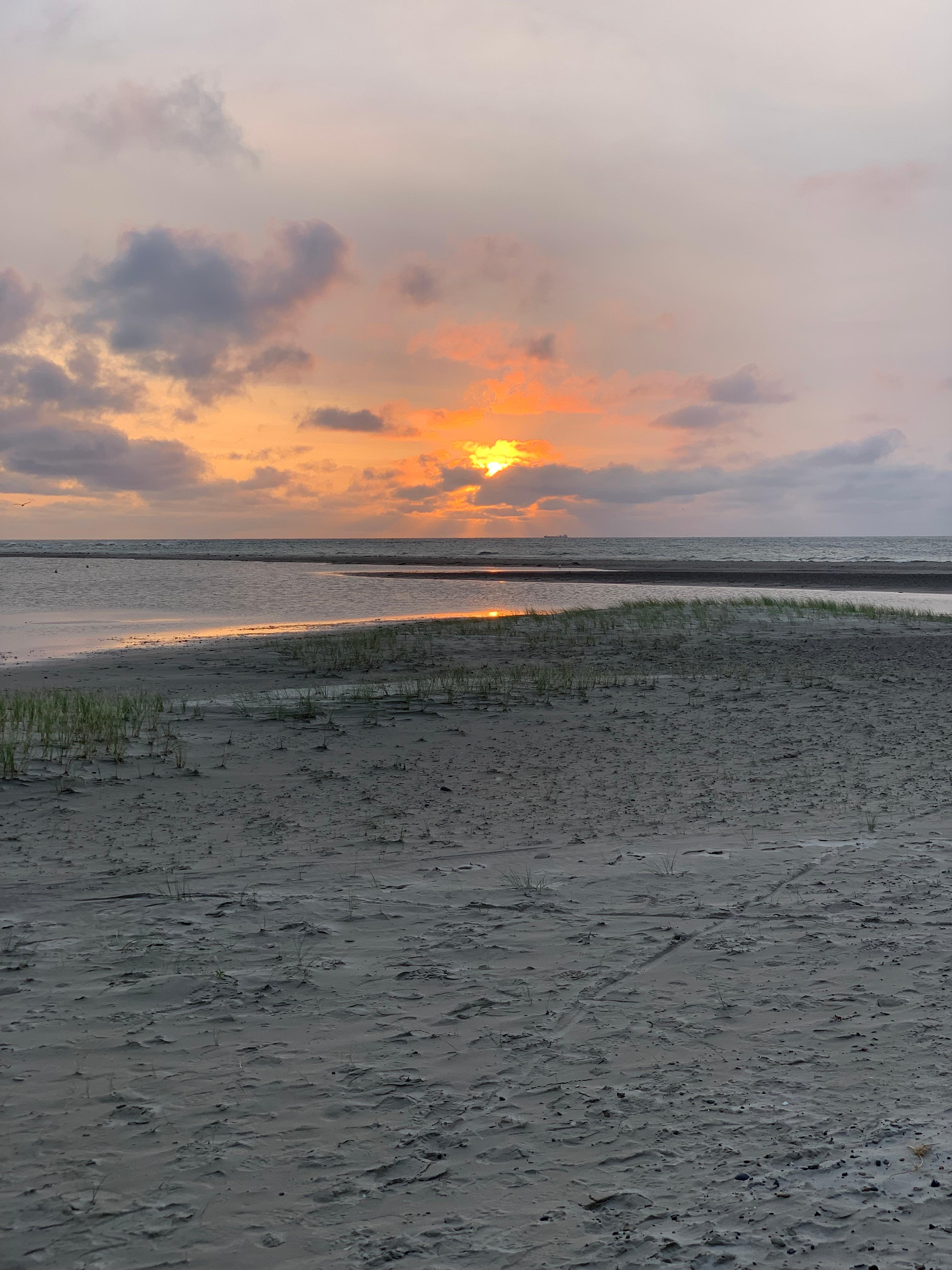
Antonia and I opened the nets at Kabeltromlen, and Simon Sr joined for the first round. We expected it to be a quiet day, as the wind was quite strong, but it turned out to be very busy. We caught several flocks of Blue Tits (Blåmejse) with 25 in one net at one point! In total we ringed 70 new Blue Tits over the morning so got plenty of opportunity to look at the plumage differences between males and females. We also ringed five Great Spotted Woodpeckers (Stor Flagspætte), including four young birds and one adult. Due to the amount of birds, Gustav, Simon Jr and Rebecca left the migration count early to come and help us at Kabeltromlen. Other highlights from the ringing today include two Lesser Redpoll (Lille Gråsisken), eight Goldcrests (Fuglekonge) and a first year Meadow Pipit (Engpiber) which is shown in the photo below.
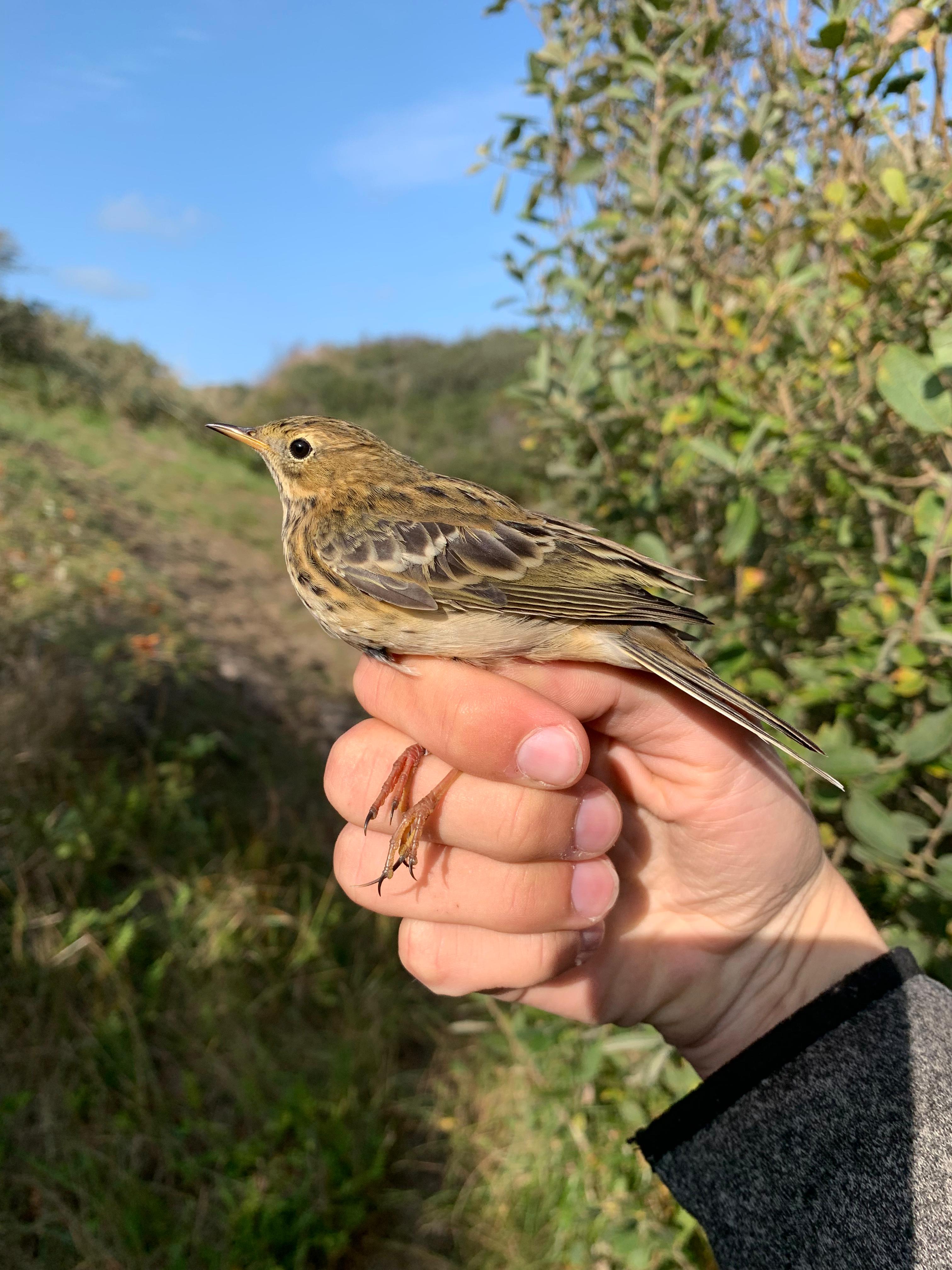
Today we also ringed a couple of adult Robins (Rødhals) which was interesting as most of the Robins we have caught so far have been young first year birds. We also ringed an adult Dunnock (Jernspurv). One feature which can be used to help determine the age of Dunnocks is the eye colour. Young birds have a dull grey-brown eye whilst adults have a reddish-brown eye. The photo below shows an adult with its reddish eye.
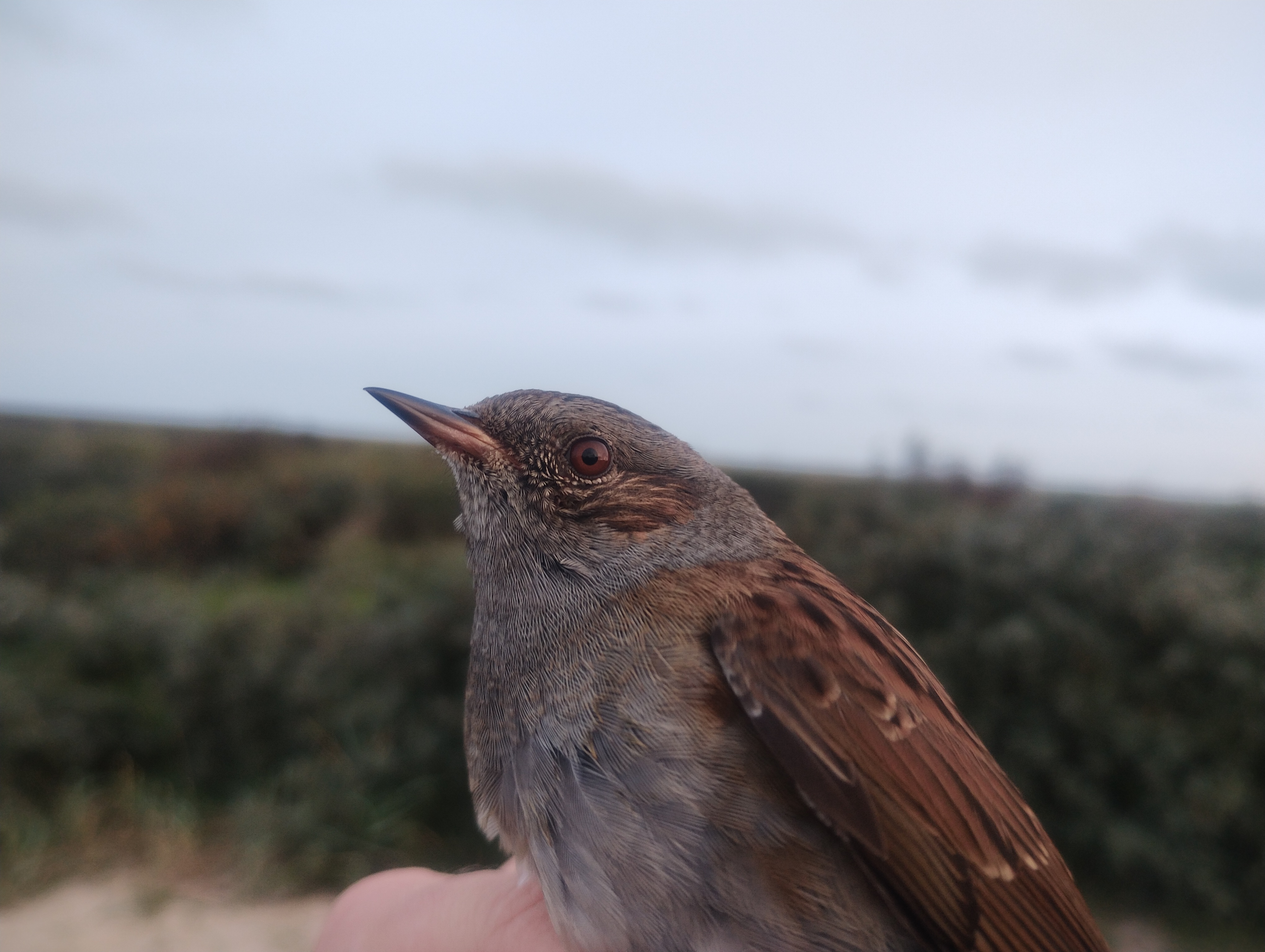
Whilst we were busy ringing the many Blue Tits (Blåmejse) we had caught, Hans and Knud continued the count at World’s End 3. They counted 174 Pink-footed Geese (Kortnæbbet Gås) and four Merlin (Dværgfalk) coming in from the sea. The first Little Bunting (Dværgværling) of the autumn has been seen roosting and Orca (Spækhugger) was also spotted today. At Kabeltromlen, we were also lucky enough to see an Osprey (Fiskeørn) and then a large male Adder (Hugorm) on our way back to the Fuglestation.
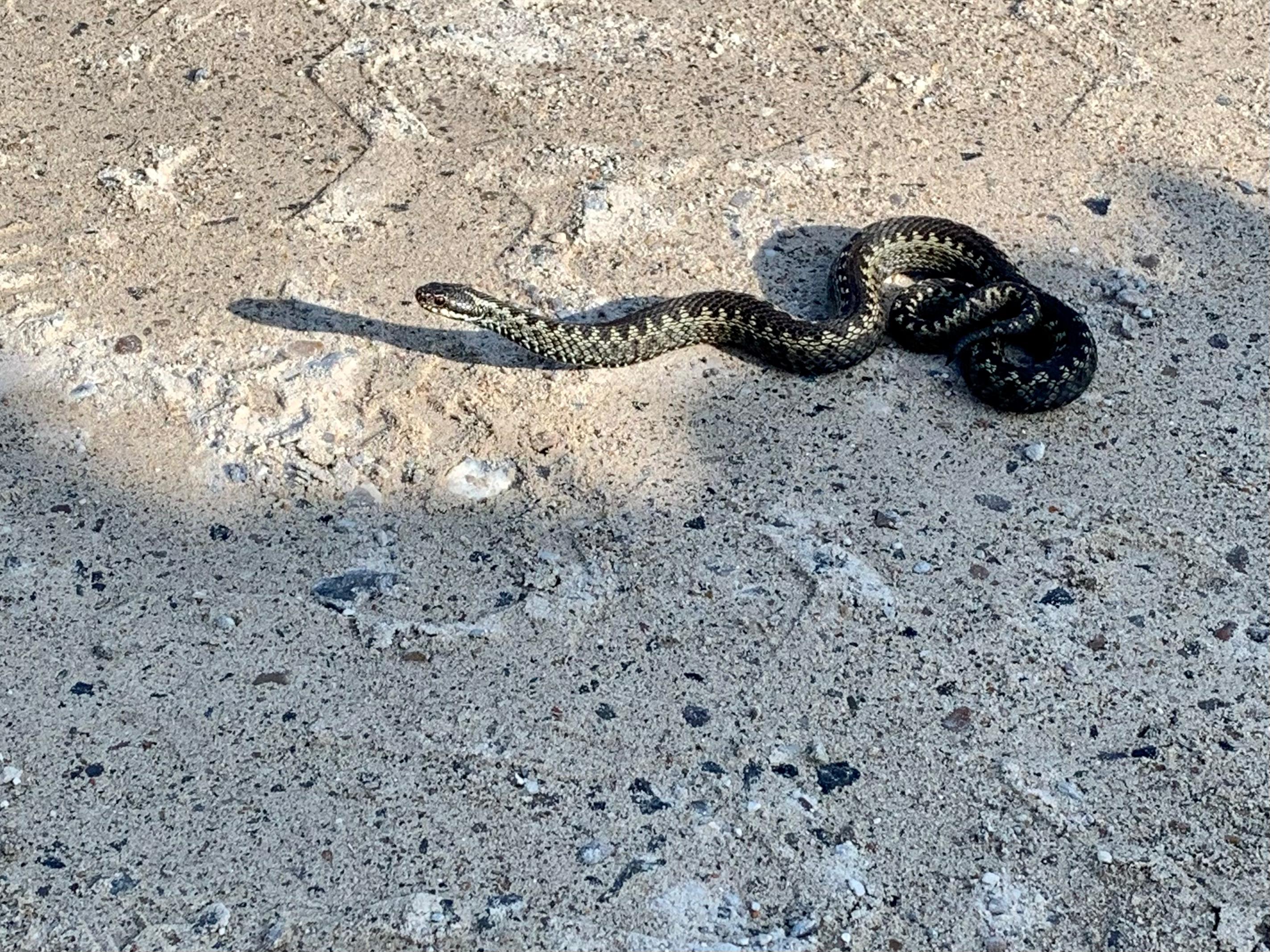
We all returned to the station in the early afternoon and had some much-needed food; delicious leftovers from the meal Hans and Birthe cooked for us last night. Immediately after Simon Sr dropped Gustav, Simon Jr and I off so we could begin the last Fulmar (Mallemuk) survey for this year. This project involves collecting dead Fulmars we find on the beach for Aarhus University so that they can analyse the plastic content of the birds’ stomachs. We didn’t find any Fulmars this time but did break the record for the time taken to complete the 10km walk, only 2.5hours! On our way back, at the Sandormen track, we were lucky enough to see two Shore Larks (Bjerglærke) just in front of us. This is a new species for me and it was so nice to see its stunning plumage so close. We also saw the Snow Bunting (Snespurv) again at World’s End 3. A great way to end a really nice walk!
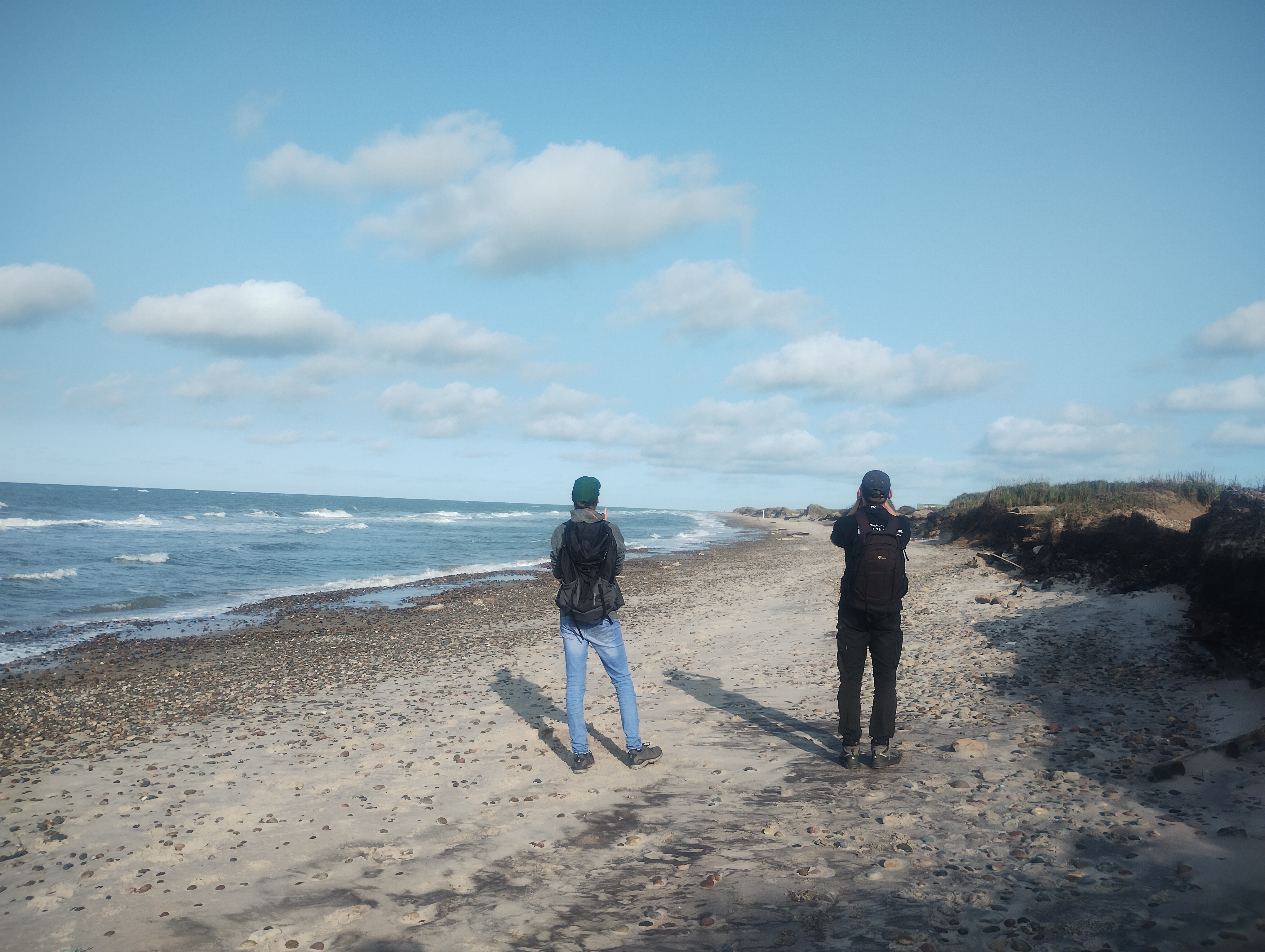
Whilst we were out, Rebecca and Antonia cleaned in the apartment and on the stairs, and updated the picture archive. They also packed up all their stuff and wrote in the guestbook as they both leave tomorrow with Rebecca returning home to Scotland and Antonia going to stay at Blåvand Fuglestation. Hans and Birthe also left today and we greeted our new guest, Søren. Later on, all the ringing data was inputted. This was a massive job with 136 new birds to enter! Ringing sheets were also checked and food shopping done. Simon Jr has two friends staying nearby and the three of them cooked us a very nice dinner. They will be joining the ringing tomorrow. Hopefully we’ll have some good birds!
Ringing (Kabeltromlekrattet)
Robin (Rødhals) – 14
Wren (Gærdesmutte) – 8
Chiffchaff (Gransanger) – 9
Blackcap (Munk) – 12
Reed Bunting (Rørspurv) – 4
Blue Tit (Blåmejse) – 70
Great Spotted Woodpecker (Stor Flagspætte) – 5
Dunnock (Jernspurv) – 3
Meadow Pipit (Engpiber) – 1
Goldcrest (Fuglekonge) – 8
Lesser Redpoll (Lille Gråsisken) – 2
Total: 136
People: Antonia Greil, Hayley Land, Rebecca Cheape, Gustav Nyberg, Simon Kiesé, Simon S. Christiansen, Hans and Birthe Christophersen, Knud Pedersen, Søren Wilhelmsen
A link to today's observations from volunteers and local observers.
Euro Birdwatch Day and the first Snow Bunting!
Firstly, this is my second last day here at Skagen Bird Observatory as I leave on Monday. My six weeks here have gone by so quickly! I have enjoyed my time here very much and have learnt so many new skills and have gained more confidence in my ringing and bird identification abilities. I have met some nice people and have enjoyed all the fun birding moments together. I don’t think there was one day without smiles and happiness with the people at the station so that was great. I would really like to return to Skagen again in the future.
Anyway, back to today… so my day started with walking to World’s End Three with Gustav and Simon to do the migration count. It was a bit windy, however, it was a northerly wind so we weren’t too exposed and could still enjoy the count. Knud and Hans also joined the count so there were many pairs of eyes scanning the sea for rare species, unfortunately there was no Sooty Shearwater (Sodfarvet Sråpe), but there was a lovely Snow Bunting (Snespurv) directly in front of us which was super nice to see, it was walking around some pebbles for about 10 minutes so we could really appreciate it, this was also my first sighting of this species!
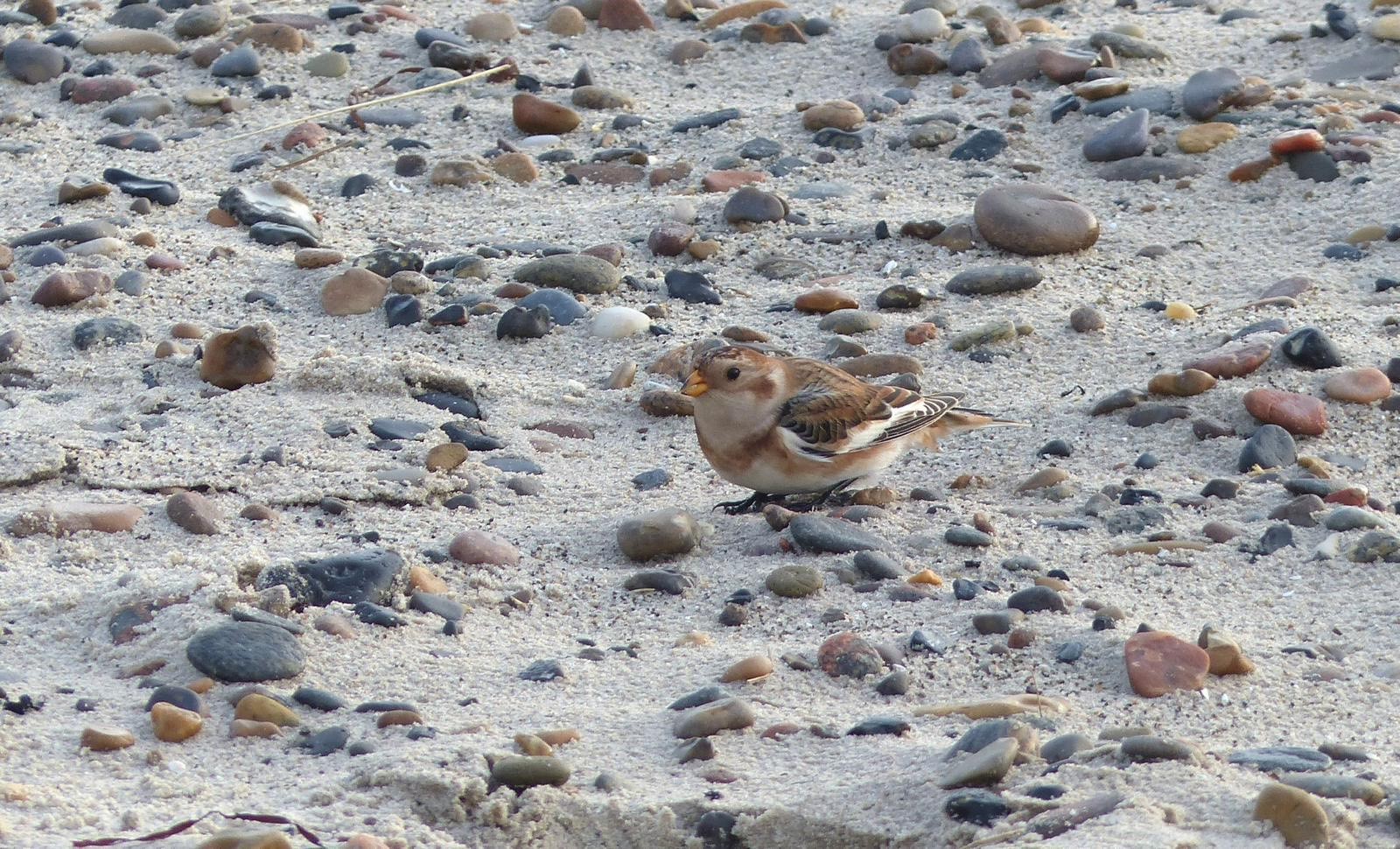 Photo: Hans Christophersen
Photo: Hans Christophersen
Other species counted today included 8 Caspian Gulls (Kaspisk måge)which should be a new day record of this species at Grenen! Gustav left the count a bit earlier than the rest of us as he joined a guided tour involving guests arriving to celebrate the The European Birdwatch Day with us.
Update: The Putative Eastern Yellow Wagtail is still in the area and many birders from Copenhagen and other areas visted today and were not disappointed!
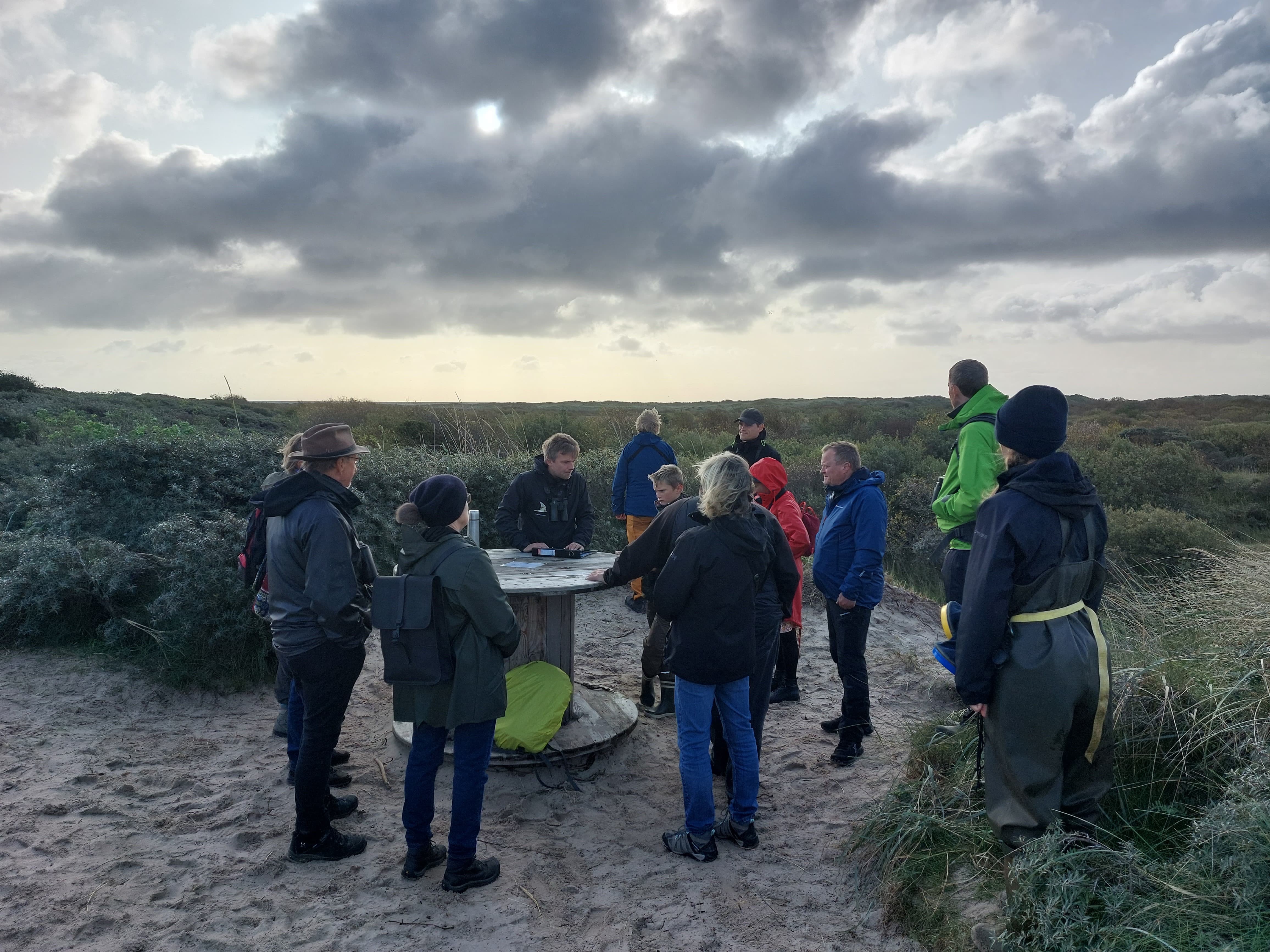
Meanwhile, Hayley and Antonia were out ringing at Kabeltromlekrattet, although not for long as it was stormy and only managed to catch two birds. However, they demonstrated the different aspects of bird ringing for some of the people from the European Bird Watch group. The nets were quickly closed after the demonstration, and they returned to the station to start cleaning up the apartment. Once we returned from the migration count, we also helped to clean up, and made sure all the cobwebs were dusted away as we always forget about them! It is so clean in here now, but let’s see how long it lasts or until one of us starts making bread…
The rest of the day involved going out to World’s End Three to see if we could find the Snow bunting (Snespurv) again and WE DID! This was also the first time both Hayley and Antonia have encountered this species and were super happy they got to see it. The guests are cooking us dinner this evening which is very kind. Hopefully it won’t be so windy tomorrow morning for bird ringing.
Ringing (Kabeltromlekrattet)
Blackcap (Munk): 1
Goldcrest (Fuglekonge): 1
Total: 2
People: Antonia Greil, Hayley Land, Rebecca Cheape, Simon Kiesé, Gustav Nyberg, Simon S. Christiansen, Hans and Birthe Christophersen, Knud Pedersen
A link to today's observations from volunteers and local observers.
Bluetits and Celebrations
Today will be my last Blog post in Skagen because I am leaving on Monday to continue the rest of my internship in Blåvand. I can’t believe my time here is already over, it didn’t feel like a month at all. Looking back to the day I arrived, I definitely can say I have learned a lot. My time here was really good, full of exciting and interesting experiences. The people I met here were a big part of that, and I am really thankful for all the laughers, shared experiences, and good conversations.
But let’s start with this day. Hayley and I woke up at 6 in the morning, but there was rain about to come, so we waited till 8 to open the nets. At this time, all the others were awake as well, so everyone helped opening the nets and we were really fast. Yesterday evening, Emil, a friend of Simon Jr. arrived and will stay here until tomorrow morning. He joined the ringing, as well as Doro, Joel and Lina. Despite opening the nets quite late, we had a lot of birds today. Over a half of them were Bluetits (Blåmejse), which were getting in the nets as little flocks. So we actually captured 32 Bluetits (Blåmejse)! We were so many people today, that with our combined forces we got them out quickly. Some nice surprises were a recaptured Willow Warbler (Løvsanger), a Common Redstart (Rødstjert) and a Reed Warbler (Rørsanger).
The Migration Count was done in different splits by Knud, Hans and Lina. There were many roosting Gannets (Sule) today, and over a 100 migrating Razorbills (Alk). A Pomarine Skua (Mellemkjove) was seen, and probably the first Snow Bunting (Snespurv) of the autumn season. In general it was a slow day, but there were a lot of people around the dunes, searching for the special bird found yesterday: The putative Eastern Yellow Wagtail, which is still in the area.
There will be stormy weather tomorrow, so we had to take down the tent where we store wooden boxes and a table. Back at the station, the kitchen was almost bursting with all the people, and we had to get more chairs from Hans and Birthe. Leftover food was eaten, a pot of coffee was made and data was entered.
After Lunch, Simon Jr. and Emil tried to get some more faecal samples from the putative Eastern Yellow Wagtail, but sadly they couldn’t get any. Meanwhile, the rest of us went to clean the bikes and put some oil in the chains. A very productive day!
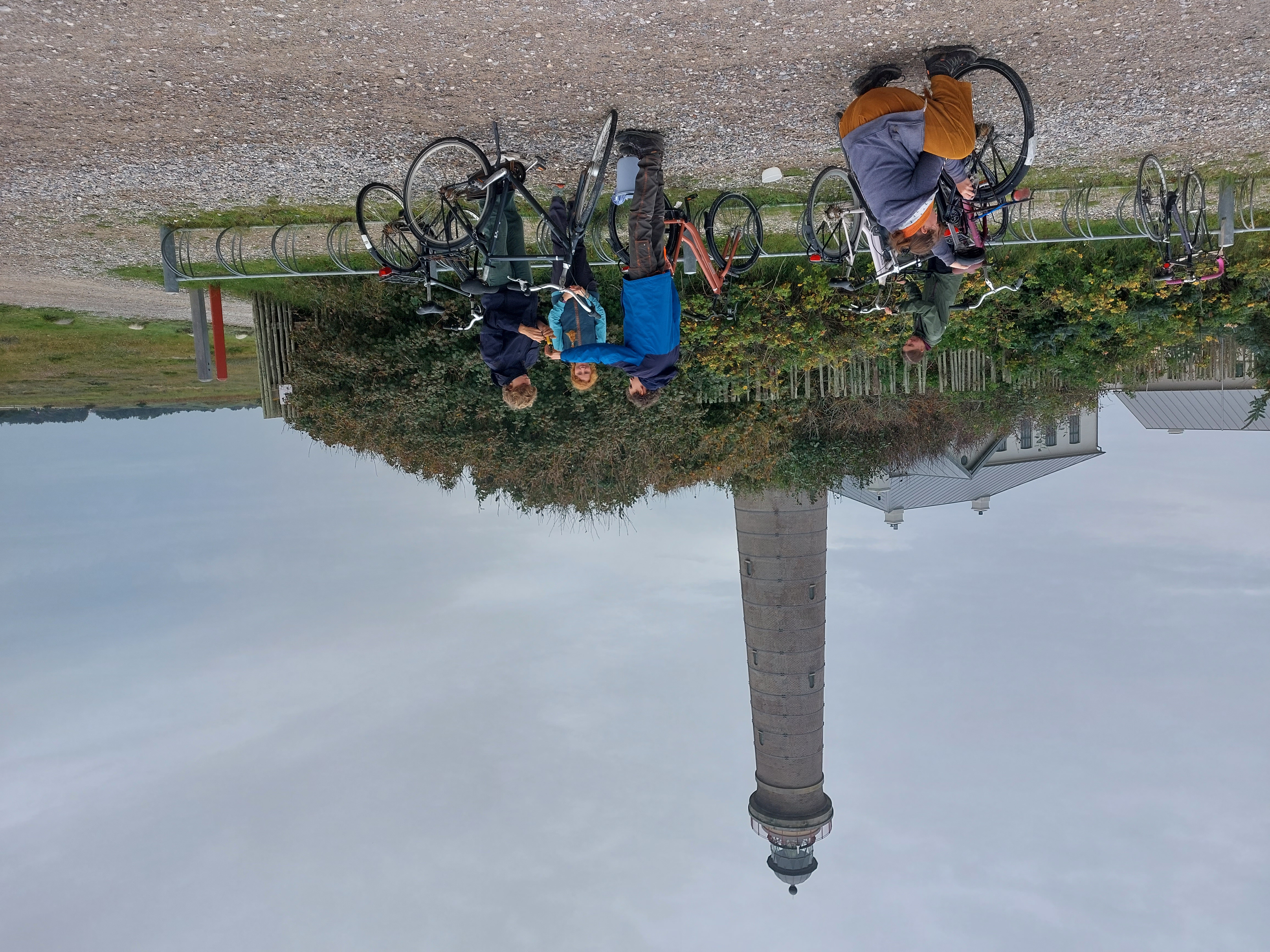
Then, the long awaited session on Skull Ossification was held by Simon Sr., which we all have been looking forward to, since it’s such an interesting topic. By looking on the skull of birds, you can identify the age, depending on if you see the limit between soft and ossificated area or only one of the two. The more ossificated, the older the bird. We took some dead birds out of the freezer and Simon Sr. showed us on those birds where to look for the limit. In the field, you can blow on the head at certain angles and try to see the limit (if it’s there) shining through the skin. As it’s not always good to see, it’s mostly used if you are not sure about the age with only looking at the feathers.
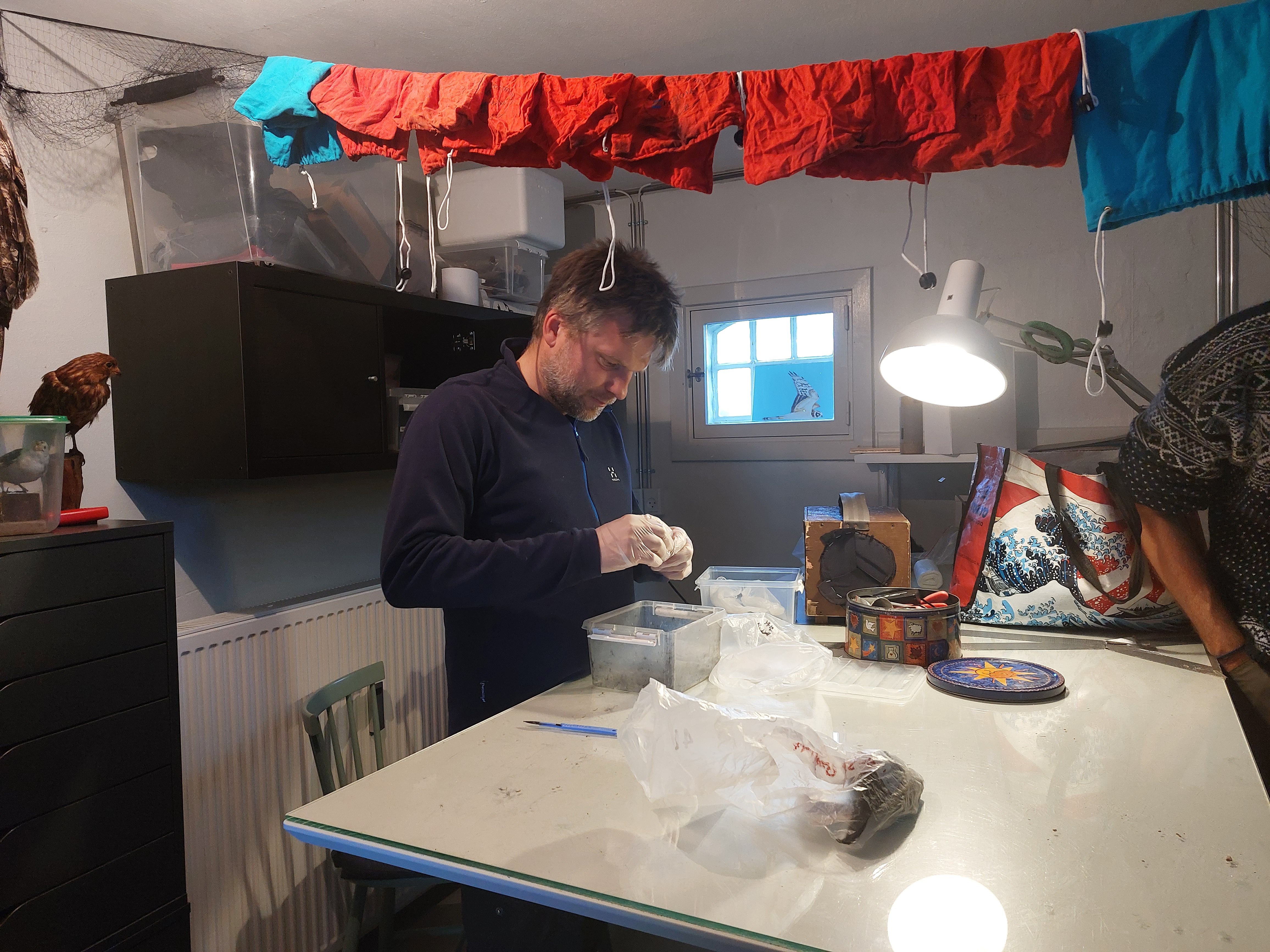
Then of course we still had to celebrate yesterday’s highlight, and especially Hans and Simon Jr., who were the first to spot the putative Eastern Yellow Wagtail! Simon Sr. had bought Champagne and together with delicious cake from downstairs we gathered in the kitchen. Everyone is still very happy which is just really nice to see.
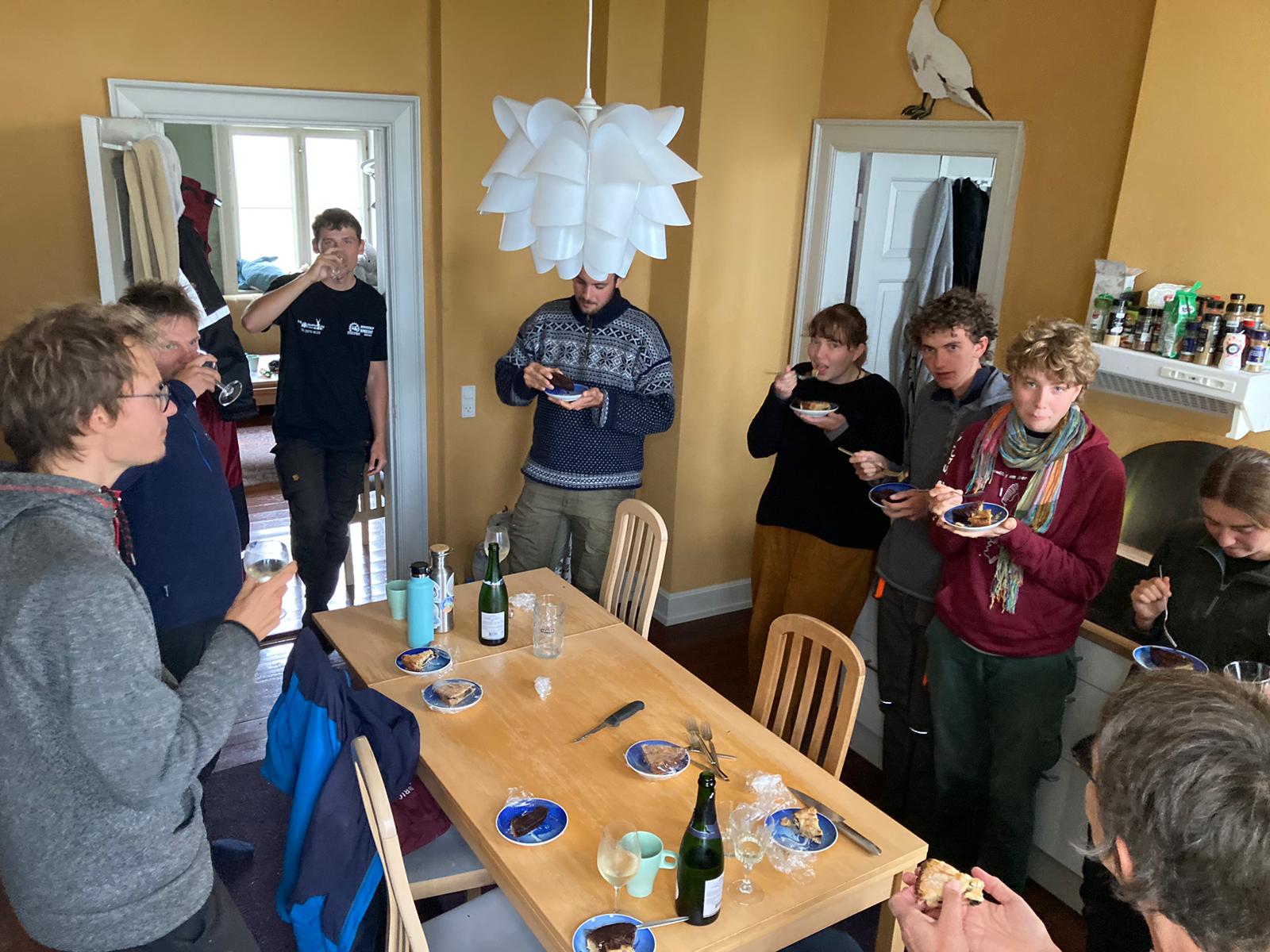
Ringing (Kabeltromlekrattet):
Bluetit (Blåmejse) – 32
Reed Warbler (Rørsanger) – 1
Chiff Chaff (Gransanger) – 3
Black Cap (Munk) – 15
Robin (Rødhals) – 1
Common Redstart (Rødstjert) – 1
Dunnock (Jernspurv) – 1
Common Redpoll (Lille Gråsisken) – 5
Total: 59
People: Antonia Greil, Hayley Land, Rebecca Cheape, Simon Kiesé, Gustav Nyberg, Simon S. Christiansen, Hans and Birthe Christophersen, Knud Pedersen, Lina Kotschi, Dorothea Engert, Joel Münch, Emil.
A link to today's observations from volunteers and local observers.
First record for Denmark!!!
Let me say this much in advance - today's blog post is really something! With so many highlights, it's really hard to keep this blog short enough that it doesn't become a novel. But let's start at the beginning.
The day started like any other - half of us went ringing at Kabeltromlen and the other half went to the tip for the seabird count. Two Black Guillemots (Tejst), close Fulmars (Mallemuk) and Dark-bellied Brent Goose (Knortegås) delighted us, even though there was not much other bird migration.The highlight were two flocks of Parrot Crossbills (Stor Korsnæb) flying overhead. Meanwhile, the ringers at Kabeltromlen made their first round and the first surprise came. A crossbill did the ringing team the honour. Thankfully they notified us and when I asked if it was a Common Crossbill (Lille Korsnæb) Simon the first replied "it is always Common Crossbill". Nevertheless, we set off to get a close-up look at the species, which is rarely caught here. When Hayley took the bird out of the bag, we immediately noticed the large head and neck as well as the strong beak. Simon, who was also seeing the bird for the first time, now realised that it was something special. "But it is always Common Crossbill" said Simon and we realised that we had indeed caught a female Parrot Crossbill (Stor Korsnæb). What a brilliant first catch for the station and just the second one ever ringed in Skagen. It was super interesting to see the identification features of the species up close and also to hear the typical calls (click here for the calls) when releasing it.
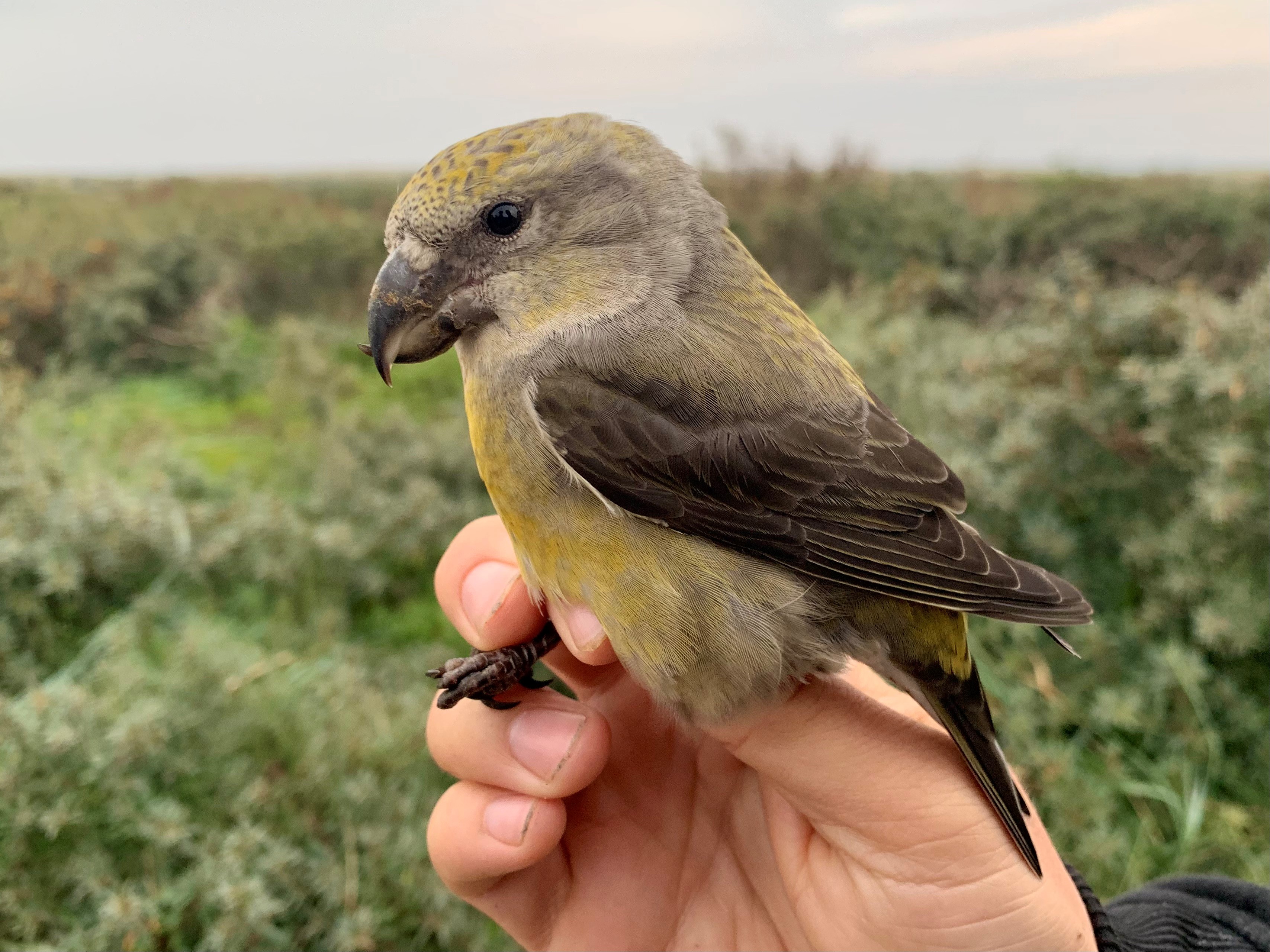
Very satisfied we went back to World's End 3 and continued the count. When it was over we walked back towards the Sandormen track. Suddenly Hans and I heard calls that sounded like a Yellow Wagtail (Gul Vipstjert). But when I found the bird in the binoculars, it was completely white and grey. This is not a Yellow Wagtail! I saw where the bird landed and we immediately started the search. When we finally found the bird, the Wagtail flew up and was now calling very harshly, a bit like a Citrine Wagtail. Then we finally saw the bird sitting free too, but visually Citrine Wagtail did not fit and my comment "we have to check for tschutschensis, the rare eastern Yellow one" became increasingly real. The first photos were taken and within minutes experts from Germany confirmed my suspicions. This is indeed an Eastern Yellow Wagtail!!!! Wow!!! I then made another Zello announcement and shortly afterwards the first observers from the surrounding area arrived. Quickly we got better clay evidence and photos and were able to observe the young Wagtail super beautifully.
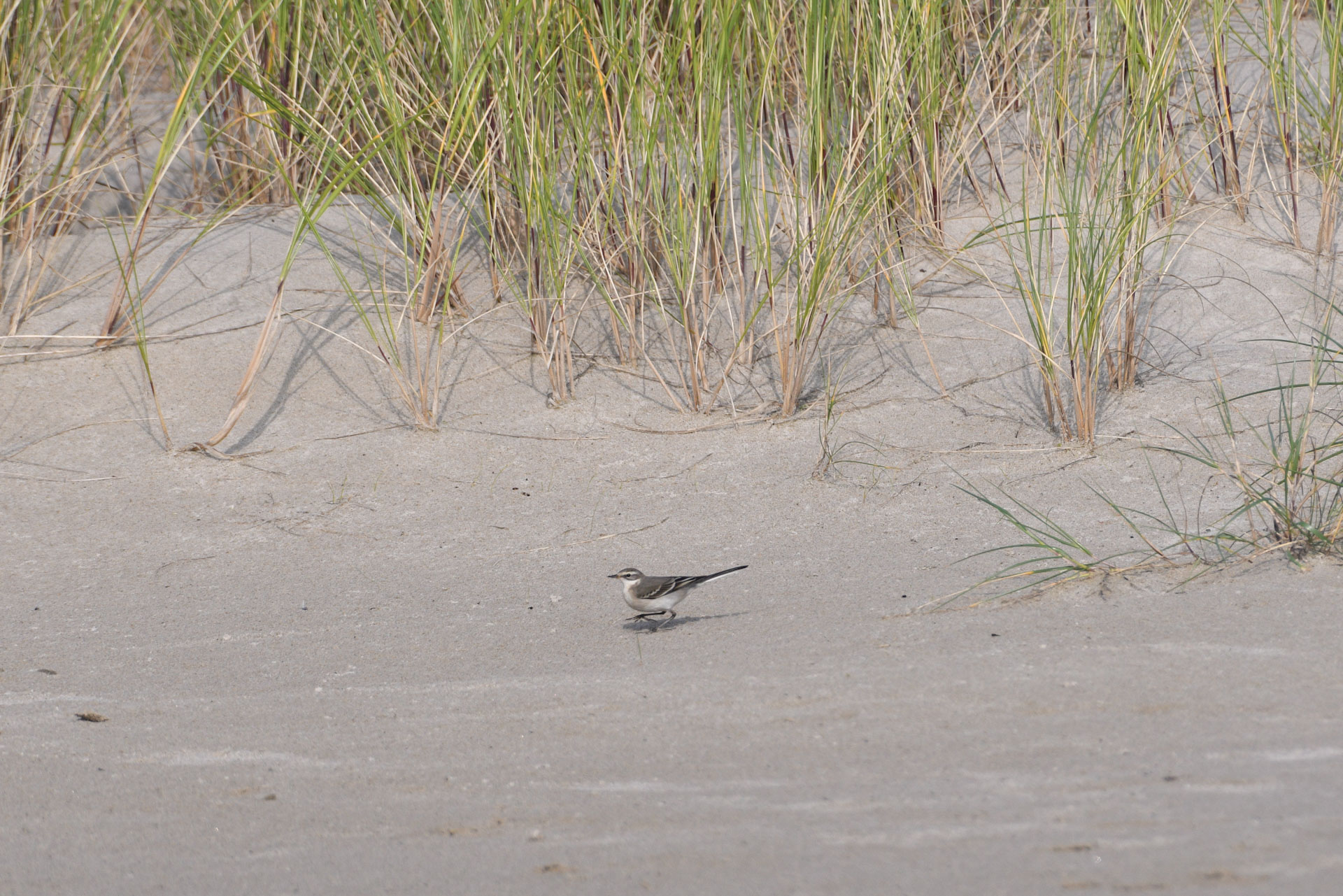
And that is exactly what determined the day. The evidence is particularly important for this species, as it is quite difficult to identify. Then I sent the recordings to the expert Magnus Robb, hoping that he will confirm the identification soon. If you want to hear the calls, click here. As the four subspecies of the Eastern Yellow Wagtail are not visually identifiable, we then tried to collect a faecal sample. This was more difficult than expected, but after about an hour we managed to collect the DNA sample. Now we just have to hope that this will be enough to identify the bird by genetics. If it is recognised by the raritee committee (which should work with the good evidence) it will be the 1st record for Denmark. Wow! Simon wants to bring champagne and Hans (with whom I found the bird) has already given a bottle of wine. What a brilliant bird. This is probably the rarest bird I have ever found myself. I am at a loss for words (that doesn't help when you are writing a blog) and I am overjoyed. All the observers and twitcher were also very nice and I got many congratulations. Thanks for that!
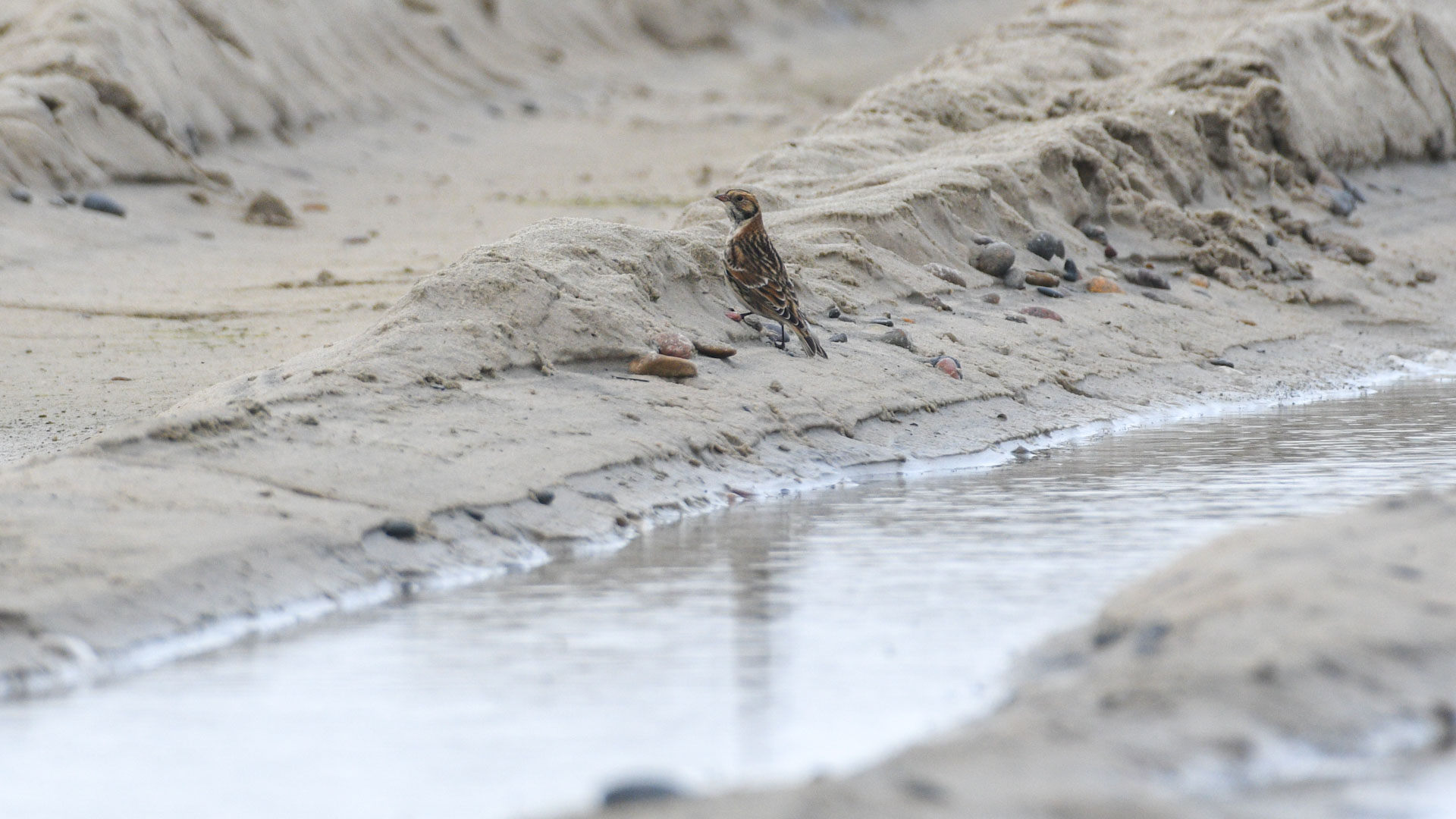 Lapland Bunting (Lapværling) at the Sandormen-Track
Lapland Bunting (Lapværling) at the Sandormen-Track
What a day! A wonderful Parrot Crossbill (Stor Korsnæb) and a putative super rare EASTERN YELLOW WAGTAIL. You can read more about the finding of that one on Netfugl.dk
Ringing (Kabeltromlekrattet):
| Blue Tit | Blåmejse | 7 | ||||||||||||||
| Parrot Crossbill | 1 | |||||||||||||||
| Great Tit | Musvit | 1 | ||||||||||||||
| Blackcap | Munk | 18 | ||||||||||||||
| Goldcrest | Fuglekonge | 1 | ||||||||||||||
| Reedbunting | Rørspurv | 2 | ||||||||||||||
| Brambling | Kvækerfinke | 2 | ||||||||||||||
| Willow Warbler | Løvsanger | 1 | ||||||||||||||
| Chiffchaff | Gransanger | 10 |
Total: 43
People: Antonia Greil, Hayley Land, Rebecca Cheape, Simon Kiesé, Simon S. Christiansen, Hans Christophersen, Knud Pedersen, Lina Kotschi, Dorothea Engert, Joel Münch.
A link to today's observations from volunteers and local observers.
The Return of the Blackbird
Hans and Dorothea joined Knud for the migration count at World’s End 3 this morning. Although the migration was quiet, they enjoyed watching a Fulmar (Mallemuk) flying close over the land. Other highlights included both Arctic Skua (Almindelig Kjove) and Great Skua (Stor Kjove), and five Caspian Gulls (Kaspisk Måge). Knud also had time to read the rings of 25 gulls!
Meanwhile, Rebecca and I opened the nets at Kabeltromlen and saw another amazing sunrise. However, just as we were opening the long line of nets in the reedbed we were surprised to hear several loud rumbles of thunder and some flashes of lightening. That hadn’t been on the weather forecast! Thankfully the storm was to the south of us and blew out to sea, so it didn’t affect our ringing plans.
Simon Sr., Oluf, Antonia, Lina and Joel all joined for the first round. It was much quieter than yesterday, but we had several nice birds including a young male Redstart (Rødstjert) and a Reed Bunting (Rørspurv). We also had time for Lina and Joel to do some extracting and release some birds. There were a few short showers of rain but luckily they didn’t last too long and we were able to continue without shutting the nets.
As with yesterday, the most caught species was Blue Tit (Blåmejse) with 12 new birds ringed. As we had more time today, we were able to look closely at the plumage colour and Simon Sr. explained the difference between male and female. Males are more brightly coloured blue and females a duller blue on the wing.
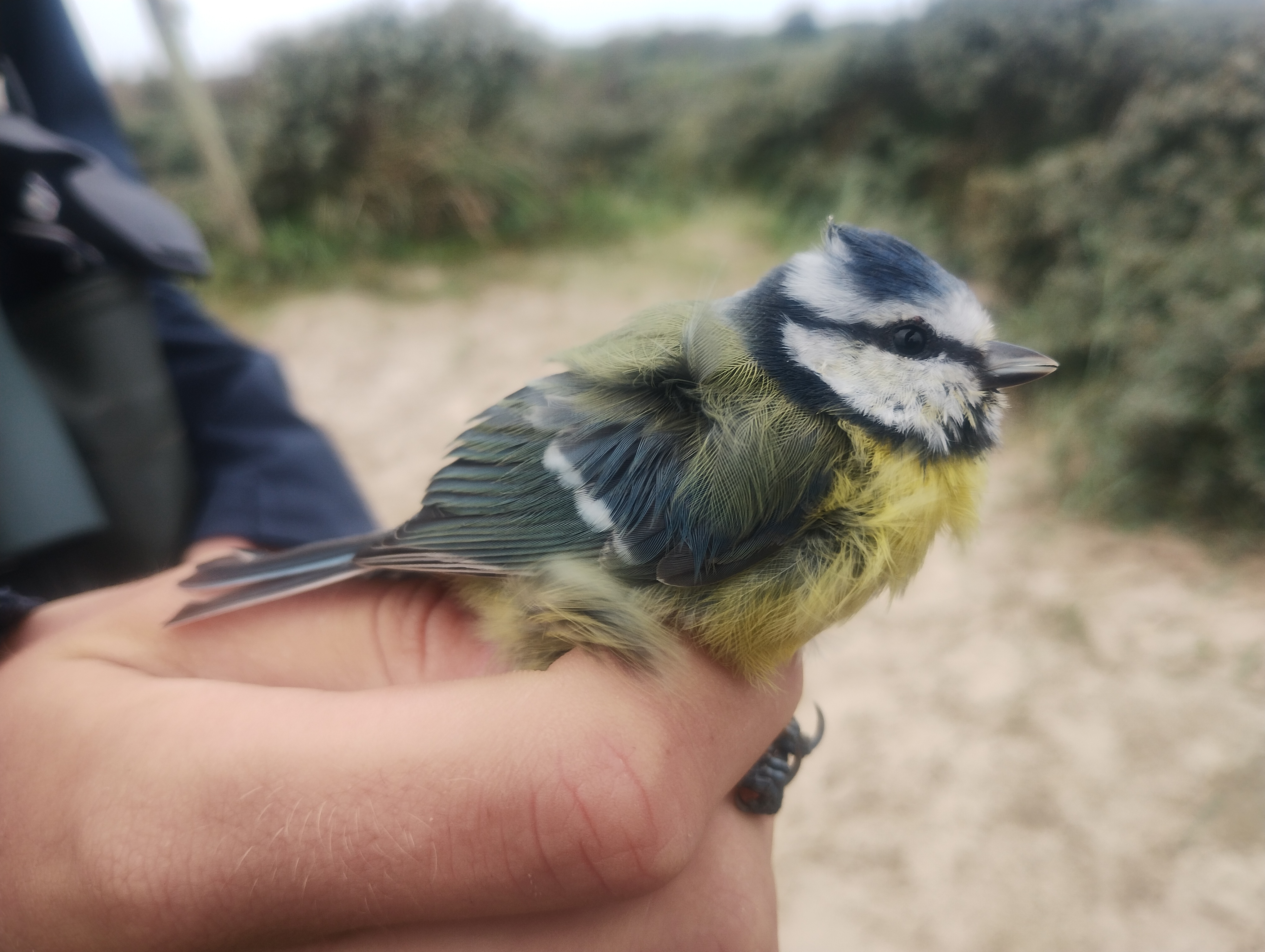
The first Song Thrush (Sangdrossel) of this autumn season was also ringed today and a young Blackbird (Solsort) was caught for the fourth time in two weeks. Interestingly, when looking back at the ringing data we saw that this individual has gained eight grams since we first caught her. Correspondingly, her fat score has also increased from one to four. It was very interesting to see this change and we were all really enjoyed seeing her again!
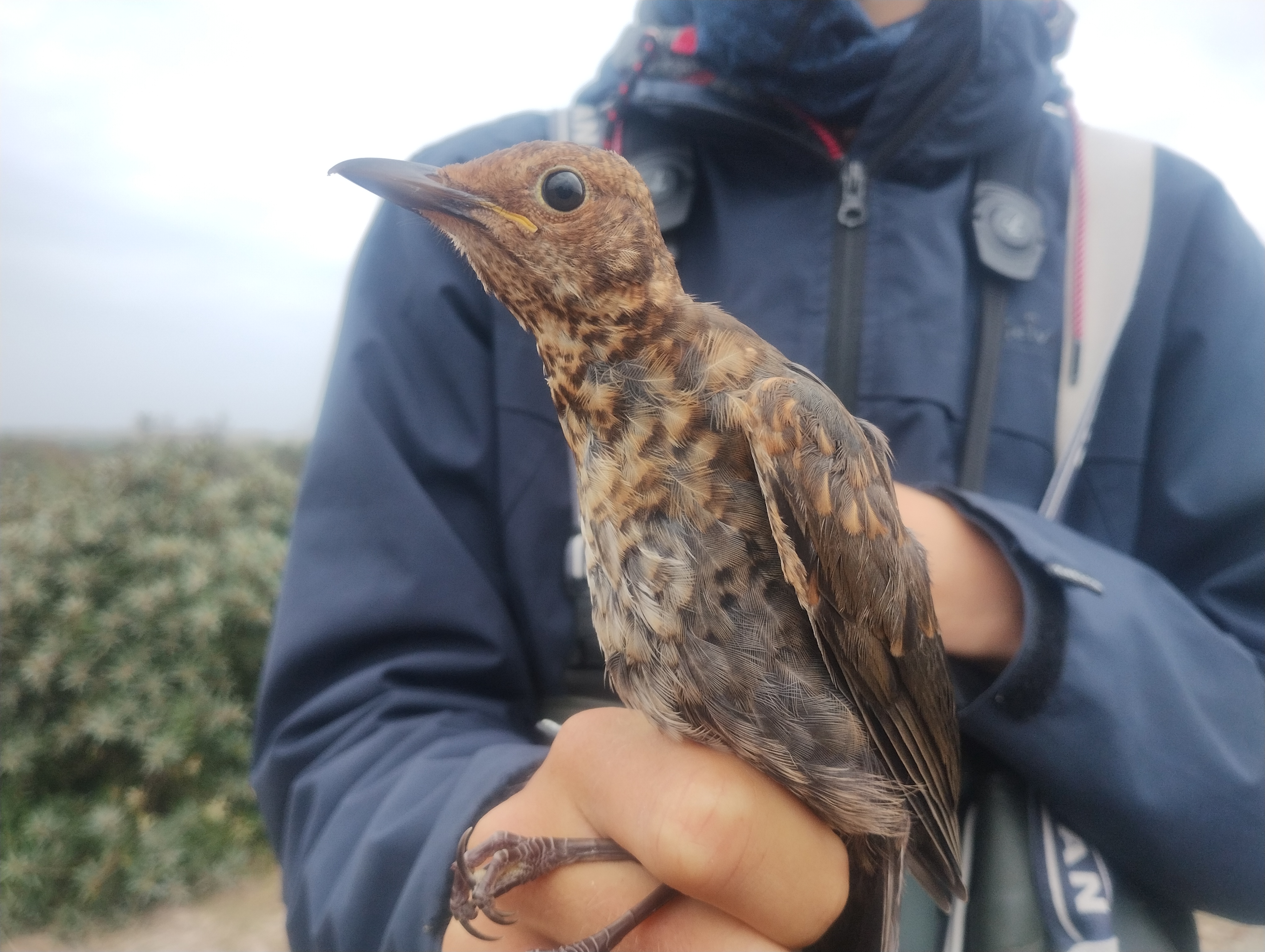
Simon Jr. was also at Kabeltromlen this morning completing a migration count of passerines whilst we were ringing. He counted around 100 Common Crossbill (Lille Korsnæb) flying very high overhead, flocks of Redpoll (Gråsisken) and Siskin (Grønsisken), plus several Greenfinches (Grønirisk) and three Goldfinches (Stillits). A Marsh Harrier (Rørhøg) and a Mute Swan (Knopsvane) were also seen. Simon also helped with extracting birds during the busiest rounds.
Later on, data was inputted and some grocery shopping done. Lina, Dorethea and Joel enjoyed a walk to Skarvsøen and Hans counted 70 Cormorants (Skarv) when he also walked past there. Back at the Fuglestation the picture archive was updated, another social media post made, and some cleaning done in the kitchen. The two nets in the lighthouse garden were opened for a couple of hours but unfortunately we didn’t catch anything. A very long Adder (Hugorm) was found though! Simon Sr. led a tour for a school group and later checked sheets with Antonia. We also visited Mette and Magnus in the lighthouse exhibition and discovered the great selection of posters they have there! Bird boxes were fixed and an owl net was set up in the evening with sound playing from a Tengmalm's Owl (Perleugle). Hopefully we’ll catch one tonight!
Ringing (Kabeltromlekrattet)
Robin (Rødhals) – 1
Wren (Gærdesmutte) – 3
Chiffchaff (Gransanger) – 4
Blackcap (Munk) – 8
Reed Bunting (Rørspurv) – 1
Blue Tit (Blåmejse) – 12
Song Thrush (Sangdrossel) – 1
Redstart (Rødstjert) – 1
Great Tit (Musvit) – 1
Total: 32
People: Antonia Greil, Hayley Land, Rebecca Cheape, Simon Kiesé, Simon S. Christiansen, Hans Christophersen, Oluf Lou, Knud Pedersen, Lina Kotschi, Dorothea Engert, Joel Münch.
A link to today's observations from volunteers and local observers.
Is it summer again?
We were able to ask ourselves this question several times today. Admittedly, the end of September is neither late autumn nor winter, but we didn't expect some of the bird species we saw today. The whole fun started early this morning, as usual, at Kabeltromlen (or how it is sometimes called if you translate it: Cable Drums or Kabeltromellen haha). Already in the first round we noticed that there were many songbirds in the area. We had strong support all morning from the three Germans who were camping at the campsite and Gustav also came to visit us with his parents.
Also thanks to the many tits (mejse) we were able to ring almost 100 birds today. Among them was a Sedge Warbler (Sivsanger), two Reed Warblers (Rørsanger) and one Garden Warbler (Havesanger). Wow. As long distance migrants, which fly to Africa they should have left now. On the other hand, it was really warm and sunny today, which made it hardly feel like autumn. At World's End 1, a Red-backed Shrike (Rødrygget Tornskade ) was busy hunting for flying insects. It too should hurry up to arrive at its wintering grounds in time.
But the absolute highlights should not remain unmentioned:
We were able to ring a Whinchat (Bynkefugl), which is apparently not so unusual for the area, but for all of us it was the first one ever in our hands. We were very pleased with that.
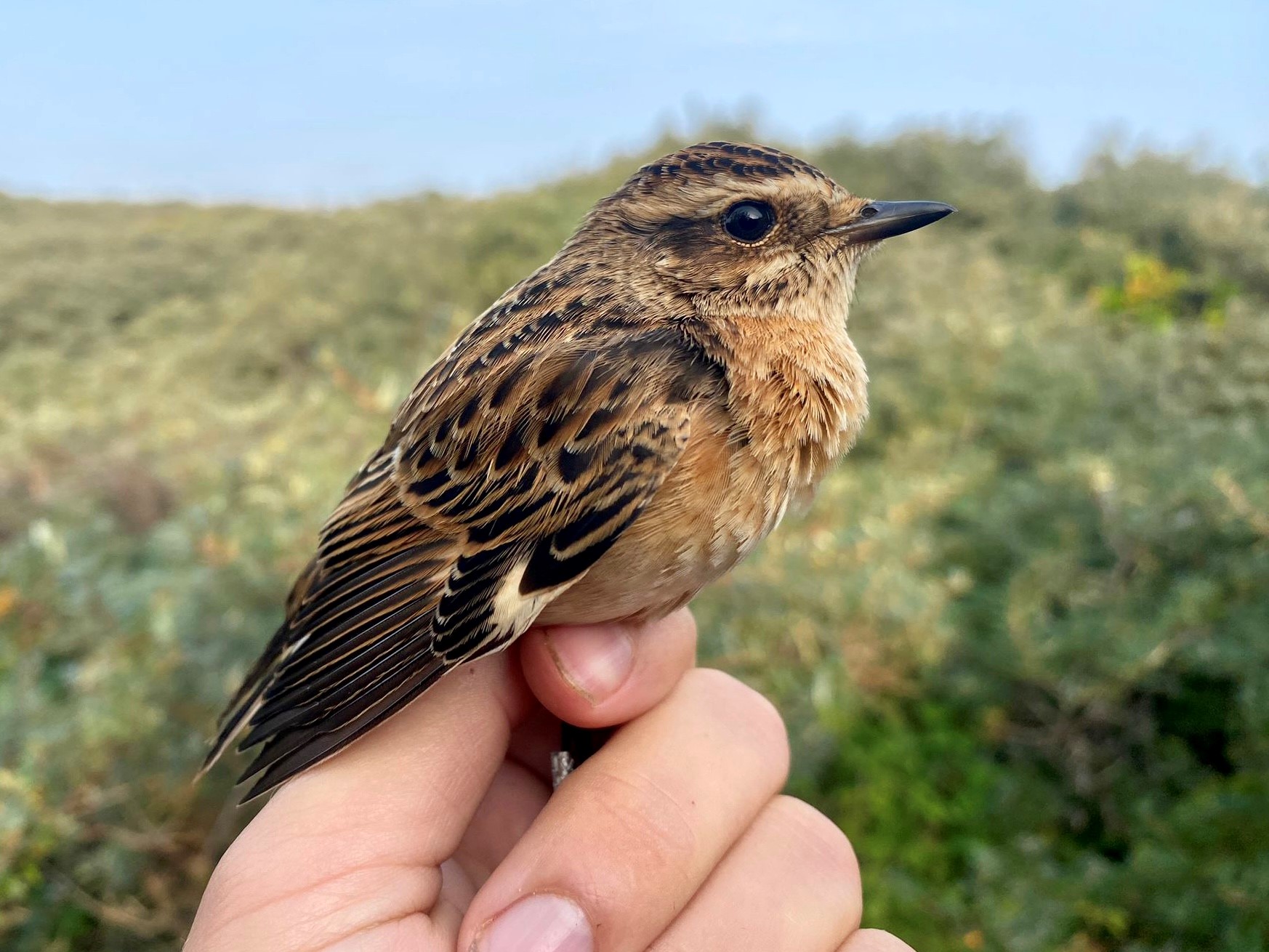 what a nice surprise - Whinchat (Bynkefugl)
what a nice surprise - Whinchat (Bynkefugl)
Then we were able to catch a male Blackcap (Munk) which already had a ring from Belgium (Brussels). That is really impressive and catches of birds ringed elsewhere are just the best you can have in ringing.
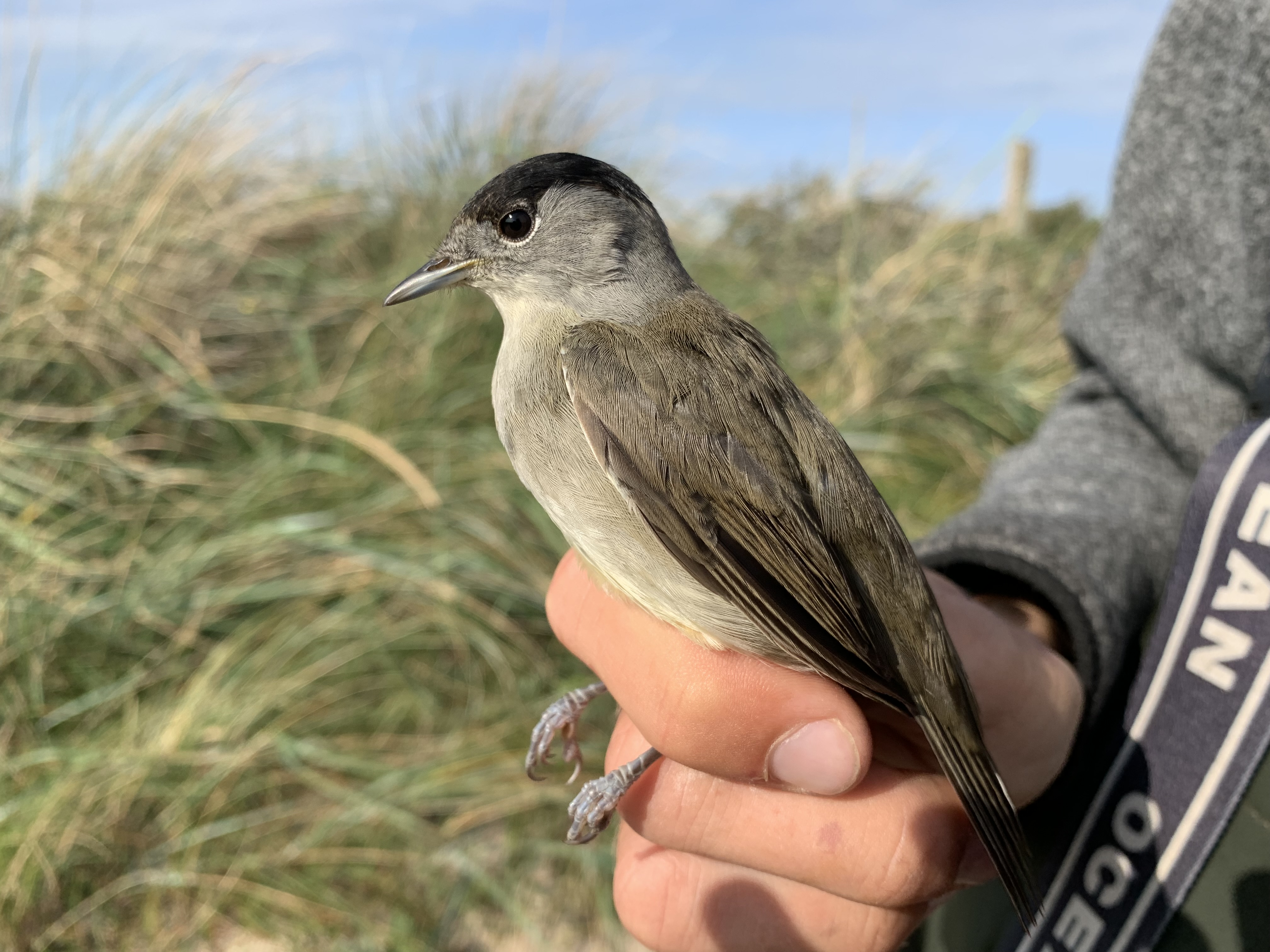 Blackcap (Munk) out of Belgium
Blackcap (Munk) out of Belgium
However, we also had birds that clearly showed that summer is definitely over. Two Lapland Buntings (Lapværling) flew over calling and left their beautiful calls on the memory card in the recorder I had placed especially for birds like this. Do you want to hear the recording? Than click here!!
With the help of the sound recording I was also able to identify a flock of 6 Crossbills flying overhead as Parrot Crossbills (Stor Korsnæb). Really cool. Other highlights include Woodlark (Hedelærke) and a late Tree Pipit (Skovpiber).
Meanwhile, our hard-working counters at World's End 3 enjoyed the beautiful sunrise. Even though there was little activity at first, various Wader species (Ryle) could be nicely observed and studied. Then some Razorbills (Alk) and Fulmars (Mallemuk) passed through. The nice weather not only made for a good time at the beach, but also at World's End for good bird migration of passerines, so birds like Linnets (Tornirisk) passed through here as well.
After a lunch break we went for a walk together through the reserve and enjoyed the birds and the beautiful weather. Afterwards we started preparing dinner, as there will be eight of us tonight. But I am sure it will be delicious!
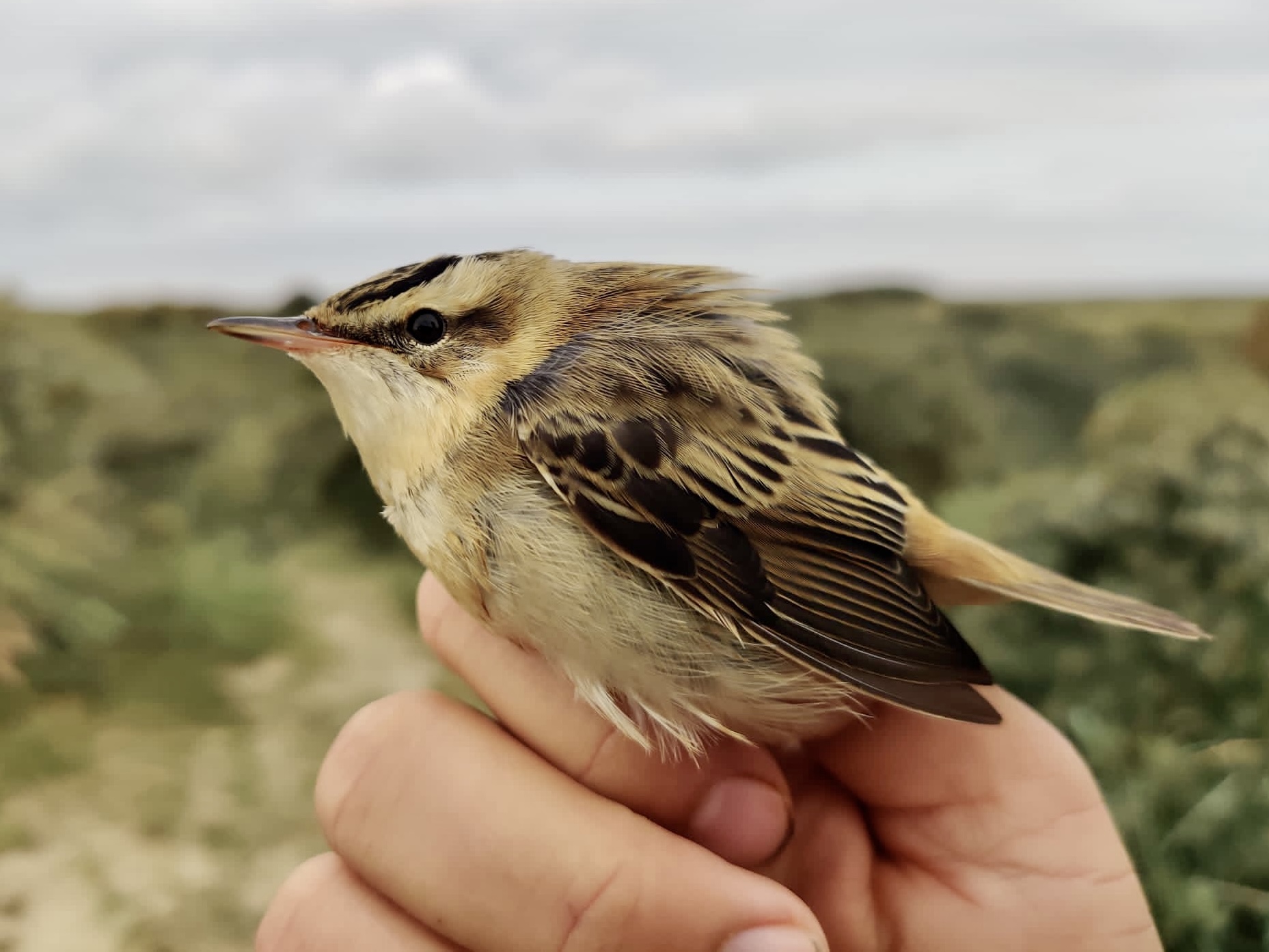 late Sedge Warbler (Sivsanger)
late Sedge Warbler (Sivsanger)
Ringing (Kabeltromlekrattet):
Total: 99
People: Antonia Greil, Hayley Land, Rebecca Cheape, Simon Kiesé, Simon S. Christiansen, Hans Christophersen, Knud Pedersen, Lina Kotschi, Dorothea Engert, Joel Münch.
A link to today's observations from volunteers and local observers.
We caught a Yellow-browed Warbler!
Today the wind was quite strong, but nonetheless Simon Jr., Hayley and Simon Sr. went ringing at Kabeltromlen in the morning. Simon Jr. and Hayley accidentally woke up to soon – imagine that! – and therefore spent the first 20 minutes of the morning playing cards in the kitchen, before they went out to open the nets. Since our newest guest, Hans, was joining Migration Count with Knud at World’s End 3, Rebecca and I took the opportunity to get a little bit of sleep. At half past 7am I was woken up by a phone call: The others had caught a Yellow-browed Warbler (Hvidbrynet Løvsanger) in the net! Rebecca and I were rushing out of bed, throwing some clothes on and speeding as fast we could to Kabeltromlen. I also took Simon Jr.’s Camera with me, so he could take nice pictures of the bird. You can see them on the bottom of this paragraph. Most remarkable on this species is the very present and clear yellowish eyestripe (which gives it its name) and the two white obvious wing bars. Knud, Hans and Alex Sand Frich were joining us to get a good look of this beautiful bird. For Denmark, this bird was just the fifth record of the species this autumn so far!
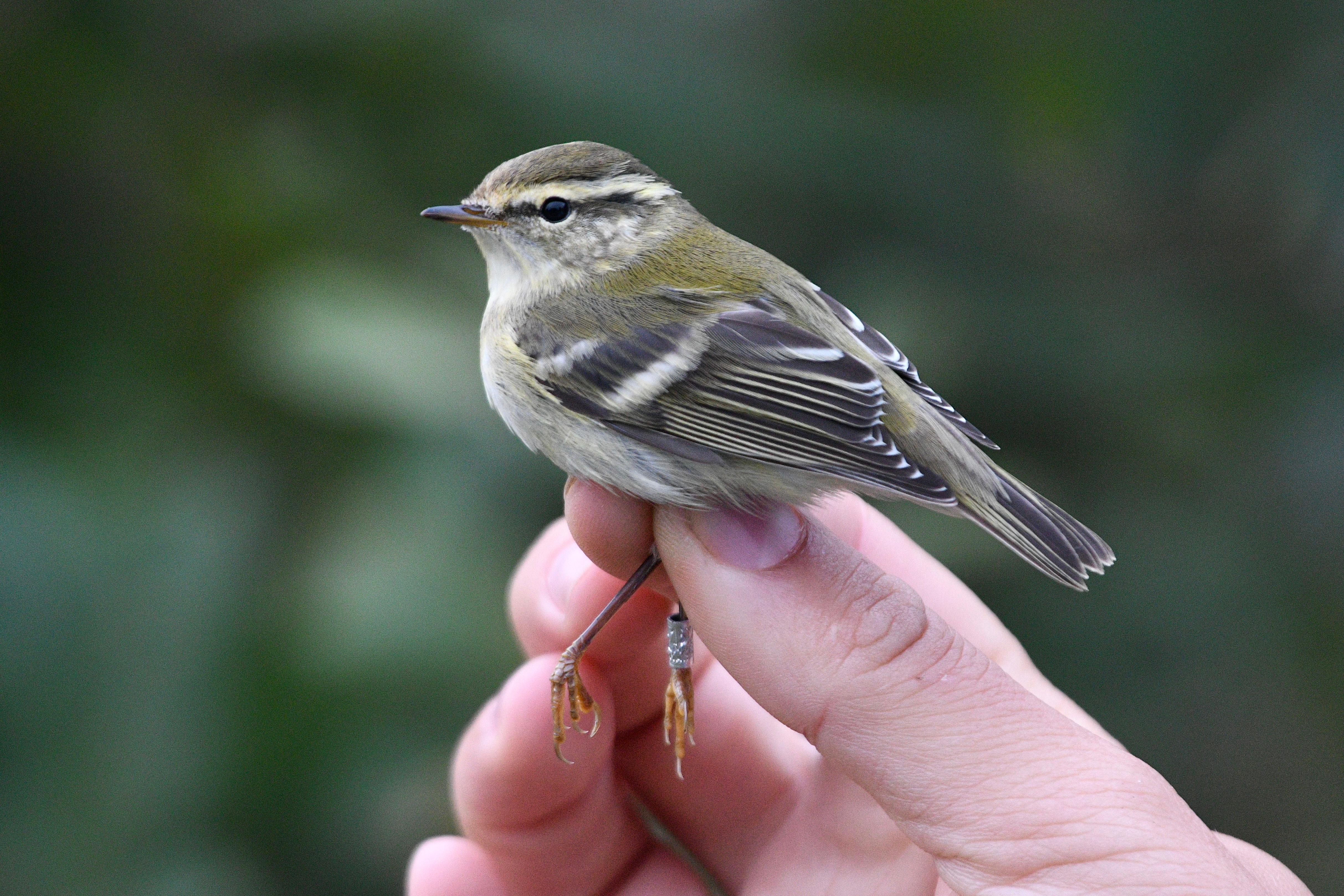
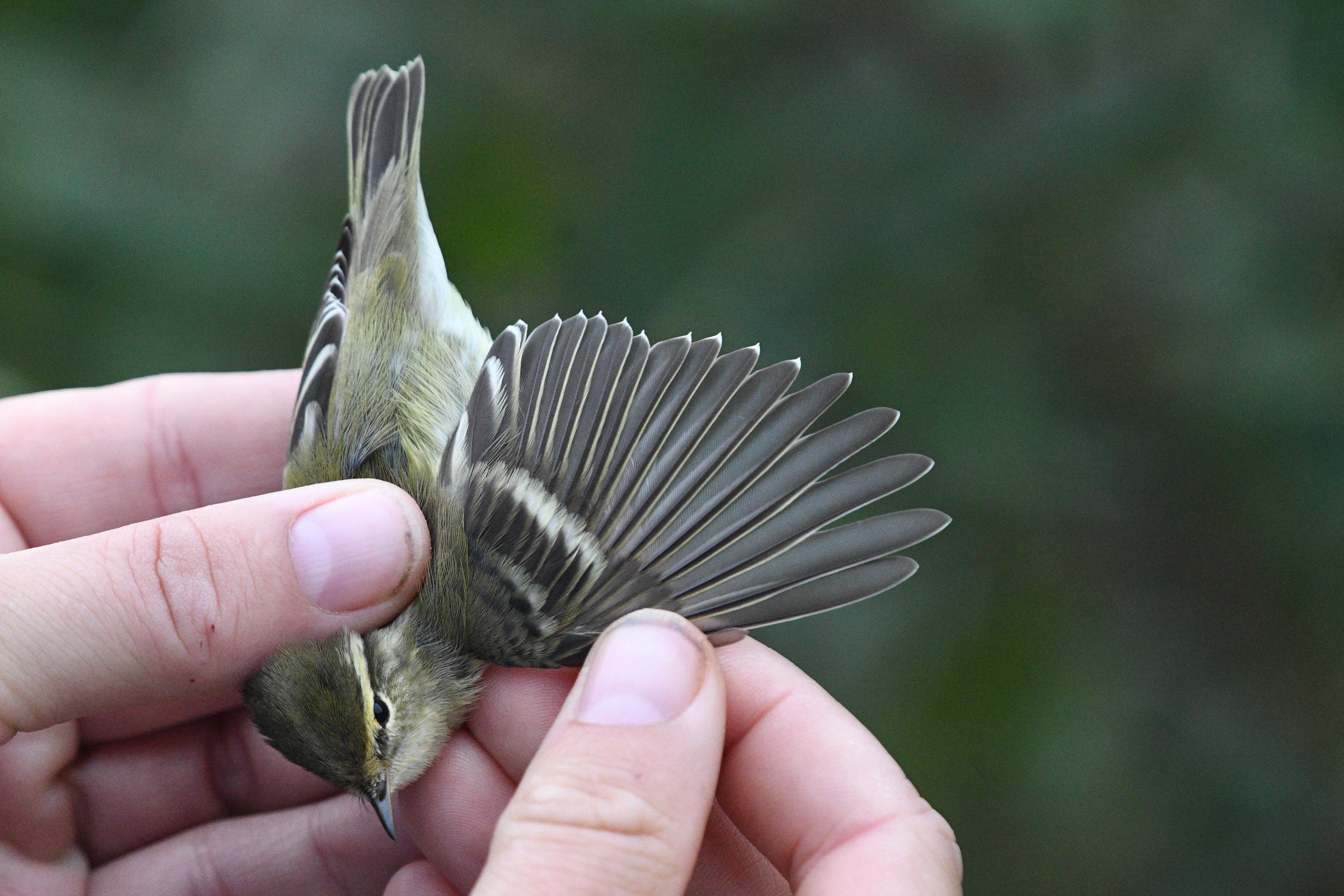
Afterwards, Rebecca and I went home again to have some breakfast, while the others were continuing the ringing session. It was a quiet day, but after the Yellow-browed Warbler (Hvidbrynet Løvsanger) it could hardly get better! They had a Lesser Whitethroat (Gaerdesanger), which is quite late at the end of September. The Hume’s Leaf Warbler (Himalayasanger) seems to still be in the area, so maybe we have luck again the next days.
Hans was having a great time at Migration Count with Knud, because a lot was going on and there was not one moment without nice birds flying over the sea. The most special bird today was a Sooty Shearwater (Sodfarvet Skråpe), but sadly none of us volunteers could see it. We therefore hope for another chance. Apart from that some Redthroated Divers (Rødstrubet Lom), a Red-necked grebe (Gråstrubet Lappedykker), a Great Northern Diver (Islom), some Razorbills (Alk) and, the first of the season, some Purple Sandpipers (Sortgrå Ryle) could be seen.
Around midday, all of us were going out for walks in the area. Hayley, Simon Jr. and I took it upon ourselves to continue Gustav’s daily walk in search of a Red-footed Falcon (Aftenfalk). We didn’t see it, but had a great time exploring the area and saw some Meadow Pipits (Engpiber), Wheatears (Stenpikker), Jay (Skovskade) and Common Snipe (Dobbeltbekassin).
Hans was so kind to give Rebecca and I a lift to the supermarket, so we could get a lot of food for the next days and didn’t have to carry all of it on our bikes. This time we got the right kind of oat milk, so that was a success. Before the daily Evening meeting, all four of us went out again to World’s End 1. While seeing a nice rainbow, we could find 15 Fulmar (Mallemuk) and 36 Razorbills (Alk).
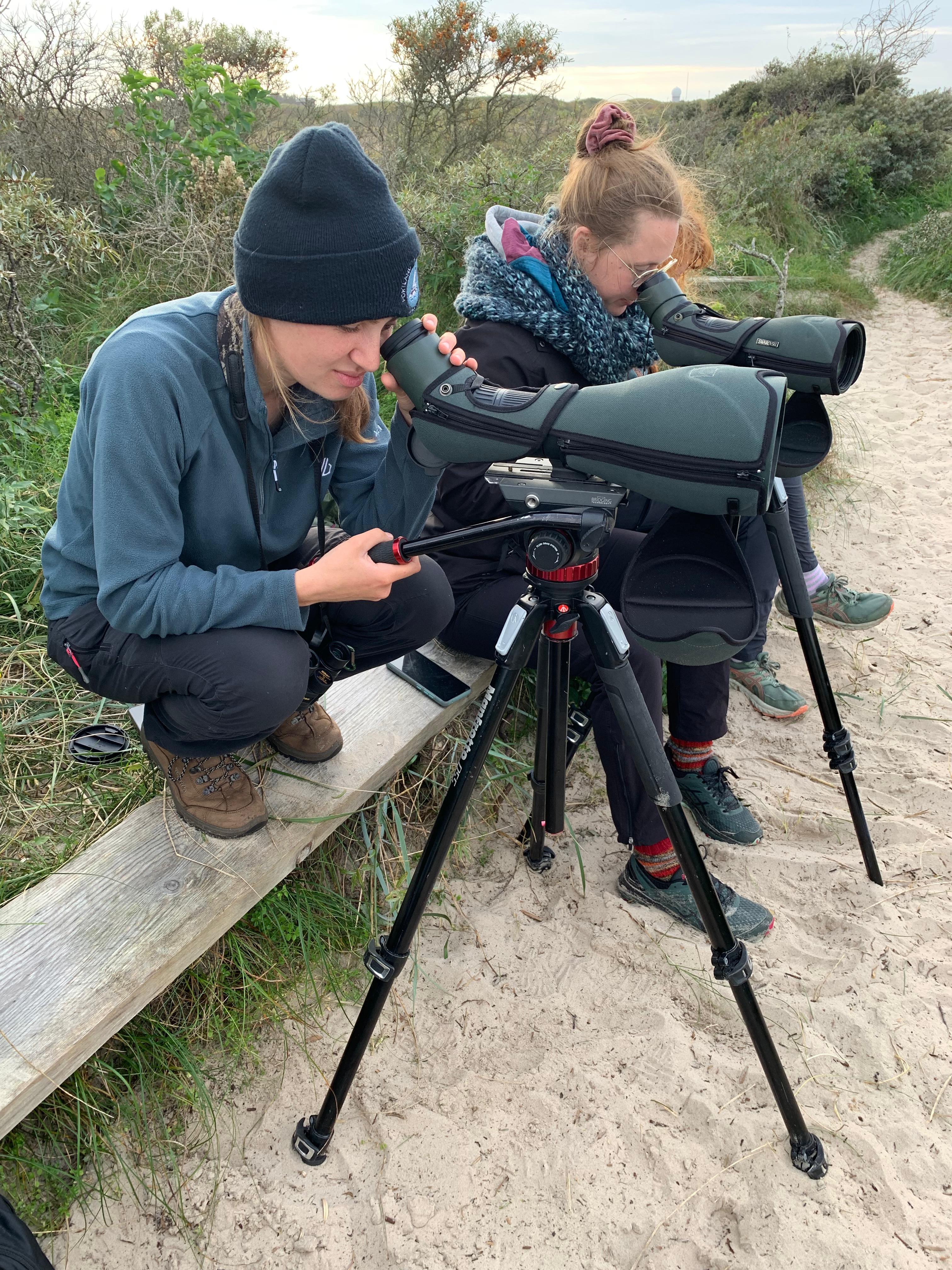
For the Evening Meeting we were not only joined by Hans, but also by three german students: Lina, Dorothea and Joel. They will be staying at the Camping Lot for one week and join us in our daily activities, like ringing and Migration Count. They have been here once before last summer und will hopefully have another great time with us in this last September week!
Ringing (Kabeltromlekrattet):
Yellow-browed Warbler (Hvidbrynet Løvsanger) - 1
Chiffchaff (Gransanger) – 1
Blackcap (Munk) – 3
Robin (Rødhals) – 1
Lesser Whitethroat (Gærdesanger) – 1
Wren (Gærdesmutte) – 1
Total: 8
Ringing (Jennes Sø):
Chiffchaff (Gransanger) – 2
Goldcrest (Fuglekonge) – 2
Crested Tit (Topmejse) – 1
Common Redpoll (Nordlig Gråsisken) – 1
Lesser Redpoll (Lille Gråsisken) – 9
Total: 15
People: Antonia Greil, Hayley Land, Rebecca Cheape, Simon Kiesé, Simon S. Christiansen, Hans Christophersen, Knud Petersen, Alex Sand Frich, Michael Anchor, Lina Kotschi, Dorothea Engert, Joel Münch.
A link to today's observations from volunteers and local observers.
Searching for the Hume's Leaf Warbler
This morning me and Antonia got up before sunrise to open the nets for another day of ringing, even though over one hundred birds were ringed yesterday we wanted to see how many we could catch today. It felt like an autumn morning as there was a chill in the air. We both agreed that it was too windy to open some of the nets amongst the reeds and therefore just opened the ones in the sheltered areas. Oluf joined us for ringing again which was nice, however we didn’t catch as many birds this morning, so we could spend a little bit more time looking at different moult limits on the birds with him. The highlight species for both me and Antonia today was a lovely bright pink Bullfinch (Lille Dompap), this was Antonia’s first time ringing a Bullfinch, so it was a great experience for her.
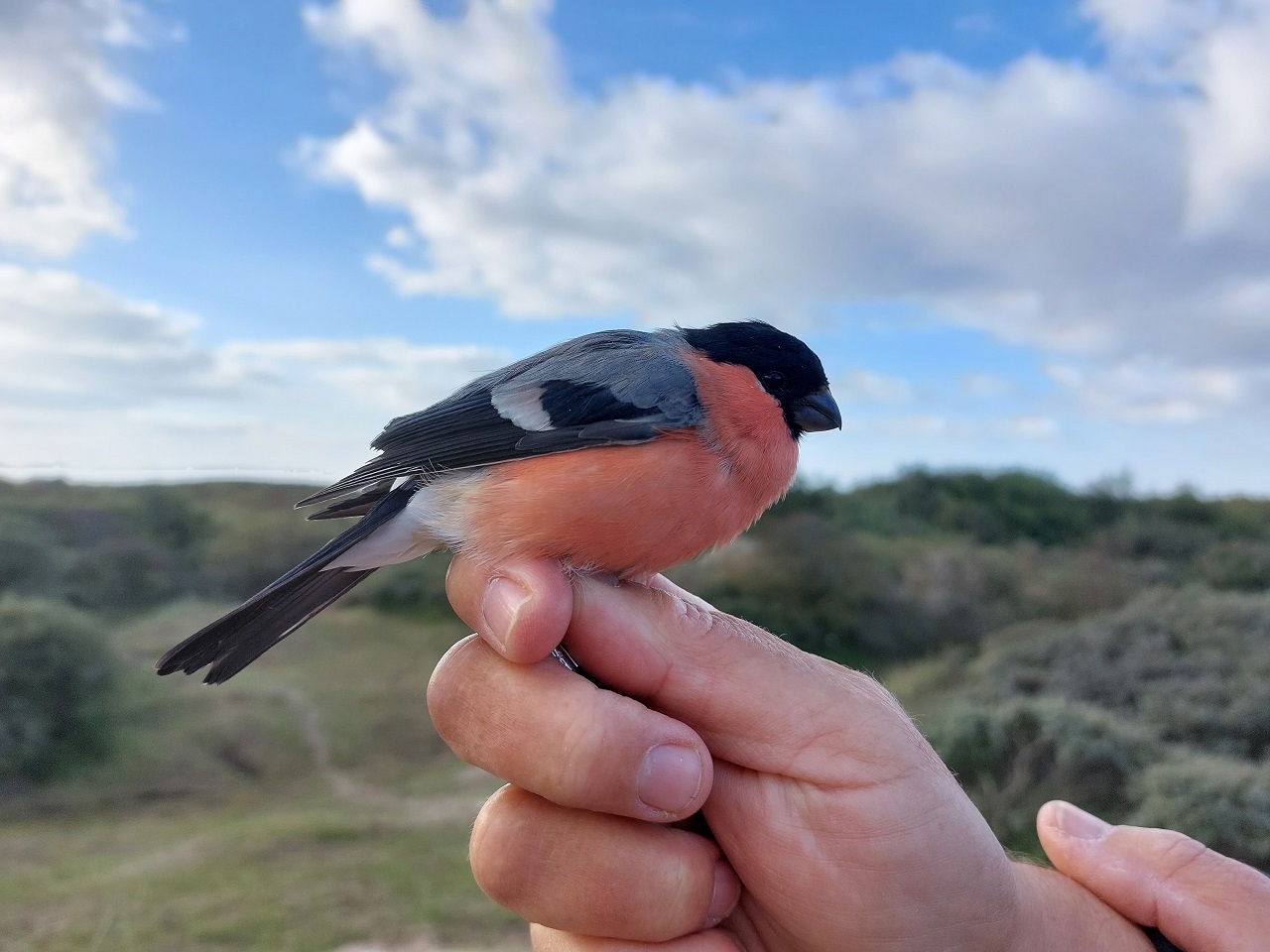
Throughout the morning there were many birders passing through Kabeltromlen on a quest to find the very elusive and rarely seen Hume's Leaf Warbler (Himalayasanger). This Warbler was found yesterday by Rolf Christensen at World’s End 1 and is only the third record of this species in Skagen. Additionally, you would not expect this species before end of October usually. It is the earliest autumn record for Denmark! The earliest until now was a record from the 30th September 2010 at Christiansø. Hopefully it will just fly straight into one of the nets someday soon whilst out foraging. That would be a nice surprise. Yesterday the warbler was called out as a Greenish Warbler (Lundsanger) first, since the calls can sound alike and the bird was only seen in short moments, but after checking the soundrecording and the few pictures everybody agreed, that it's really an early Hume's Leaf Warbler. The image below shows a spectrogram of the calls of this Hume's Leaf (middle), compared to another Hume's (left) and a Greenish Warbler (right).
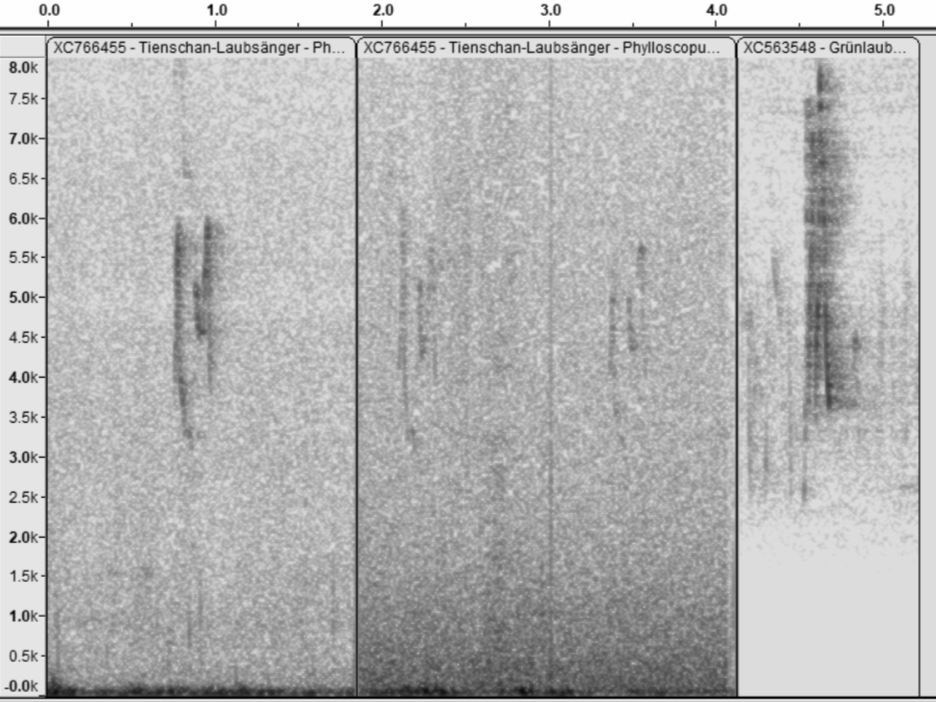 Spectogram: Hume's Leaf Warbler, our Hume's Leaf Warbler, Greenish Warbler
Spectogram: Hume's Leaf Warbler, our Hume's Leaf Warbler, Greenish Warbler
You can hear a recording from today of the Hume's Leaf, recorded by Alex Sand Frich on this link to Dofbasen
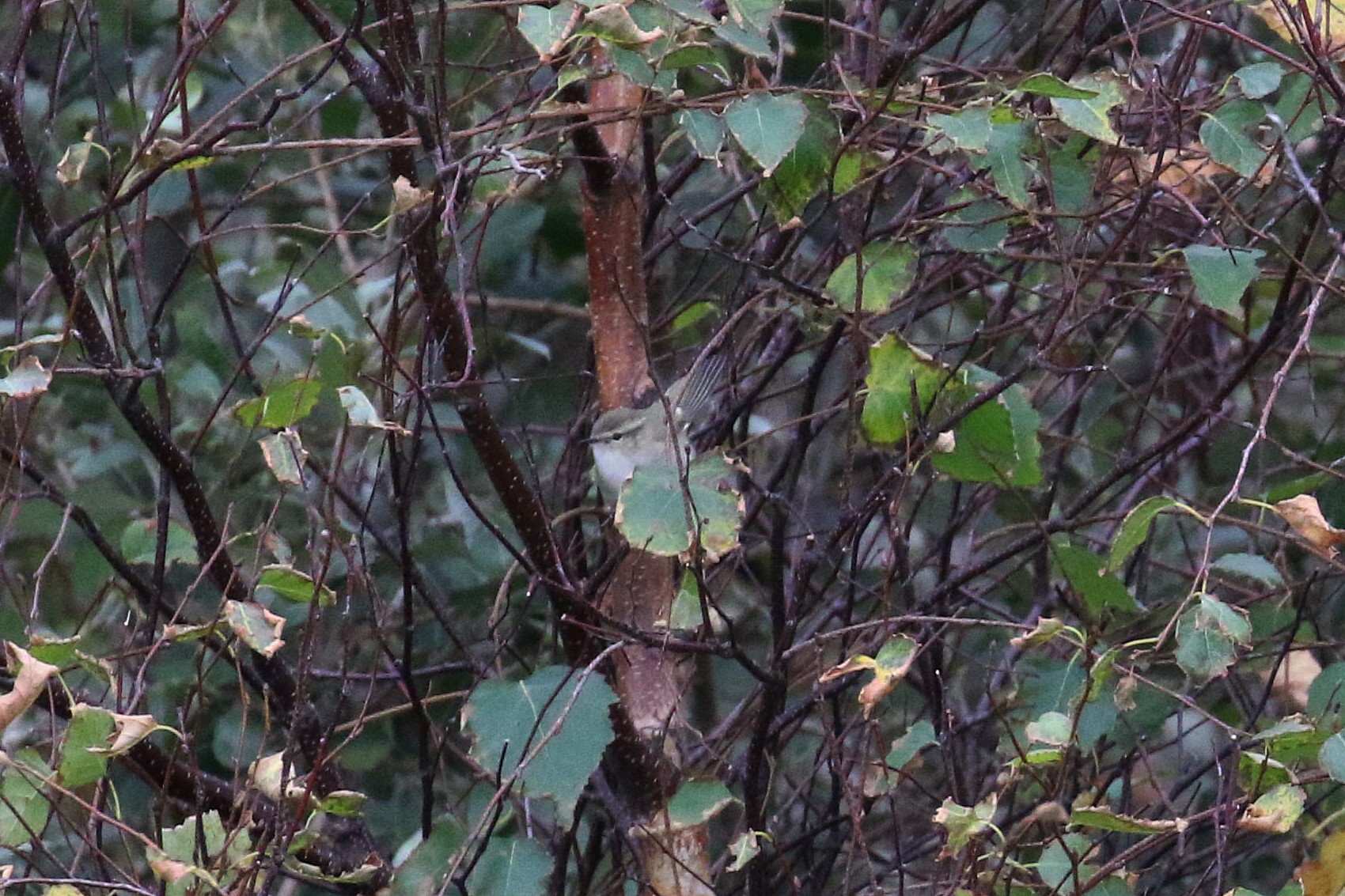 Hume's Leaf Warbler 23/9 by Alex Sand Frich
Hume's Leaf Warbler 23/9 by Alex Sand Frich
Whilst we were out ringing, Hayley and Simon Jr. were at World’s End 3 with Knud and they counted some very nice species in great numbers which included over 600 Gannets (Sule), 2 Great Skuas (Stor Kjove), 91 Pink-footed goose (Kortnæbbet Gås), 1 Merlin (Dværgfalk) and one amazing new bird species seen for Simon Jr. a Leach’s Storm Petrel (Stor Stormsvale) which migrated into northwesterly direction. The past few days have been great for rare birds. I wonder what birds will appear in the next week before I leave the station. While we where out at Grenen Michael Ancher ringed at Jennes Sø. Highlights from here was Crested Tits (Topmejser) and a Long-tailed Tit (Halemejse).
The rest of the day involved data entering (and checking), cleaning and welcoming the new guest. Simon Jr. cooked another delicious dinner, but did so much at the same time that the fuse suddenly blew. After a spark flew at the first attempt to switch the fuse back on, it worked at the second attempt.
Ringing (Kabeltromlekrattet):
Munk (Blackcap) - 6
Fuglekonge (Goldcrest) - 4
Gransanger (Chiffchaff) - 2
Gæerdesmutte (Wren) - 2
Rødhlas (Robin) - 5
Jernspurv (Dunnock) - 3
Lille Dompap (Bullfinch) - 1
Lille Gråsisken (Lesser Redpoll) - 3
Dobbeltbekkasin (Common Snipe) - 1
Blåmejse (Blue Tit) - 7
Total: 34
Ringing (Jennes Sø):
Rødstjert (Redstart) - 1
Munk (Blackcap) - 2
Gransanger (Chiffchaff) - 3
Sydlig Halemejse (Long-tailed Tit) - 1
Topmejse (Crested Tit) - 2
Blåmejse (Blue Tit) - 3
Lille Gråsisken (Lesser Redpoll) - 39
Lille Dompap (Bullfinch) - 1
Total: 52
People: Antonia Greil, Hayley Land, Rebecca Cheape, Gustav Nyberg, Simon Kiesé, Oluf Lou, Knud Petersen, Michael Ancher, Simon S. Christiansen.
A link to today's observations from volunteers and local observers.
A flock of Longtailed Tits and more
When Hayley and I went out this morning to open the nets at Kabeltromlen, we didn’t know we would stay there for 8 whole hours. It was an awesome day!
Joined by Oluf and Simon Jr., the first round was rather quiet, compared to what would expect us for the second round. We ringed about 15 birds, accompanied by visitors: our guests Jette and Anders, and Gustav with his family, which are on vacation here. Then from the second round onwards, the birds came. Many birds. We developed a well-functioning system to ring and measure the birds as quickly and precisely as possible. Teamwork it is! Rebecca joined us from Migration Count to support us, and therefore some of us could walk the rounds while the others were ringing the birds. We had several highlights, but most exciting for all of us were definitely the Longtailed Tits (Halemejse), which came in as a little flock of 8 birds, altogether in one net. Five of them could be identified as subspecies europaeus, which have dark feathers on the head. Another subspecies, caudatus, has purely white feathers on the head. Some of them where mainly white on the head but with some dark feathers admixed so. On those we therefore coul'dnt exclude genens of europaeus.
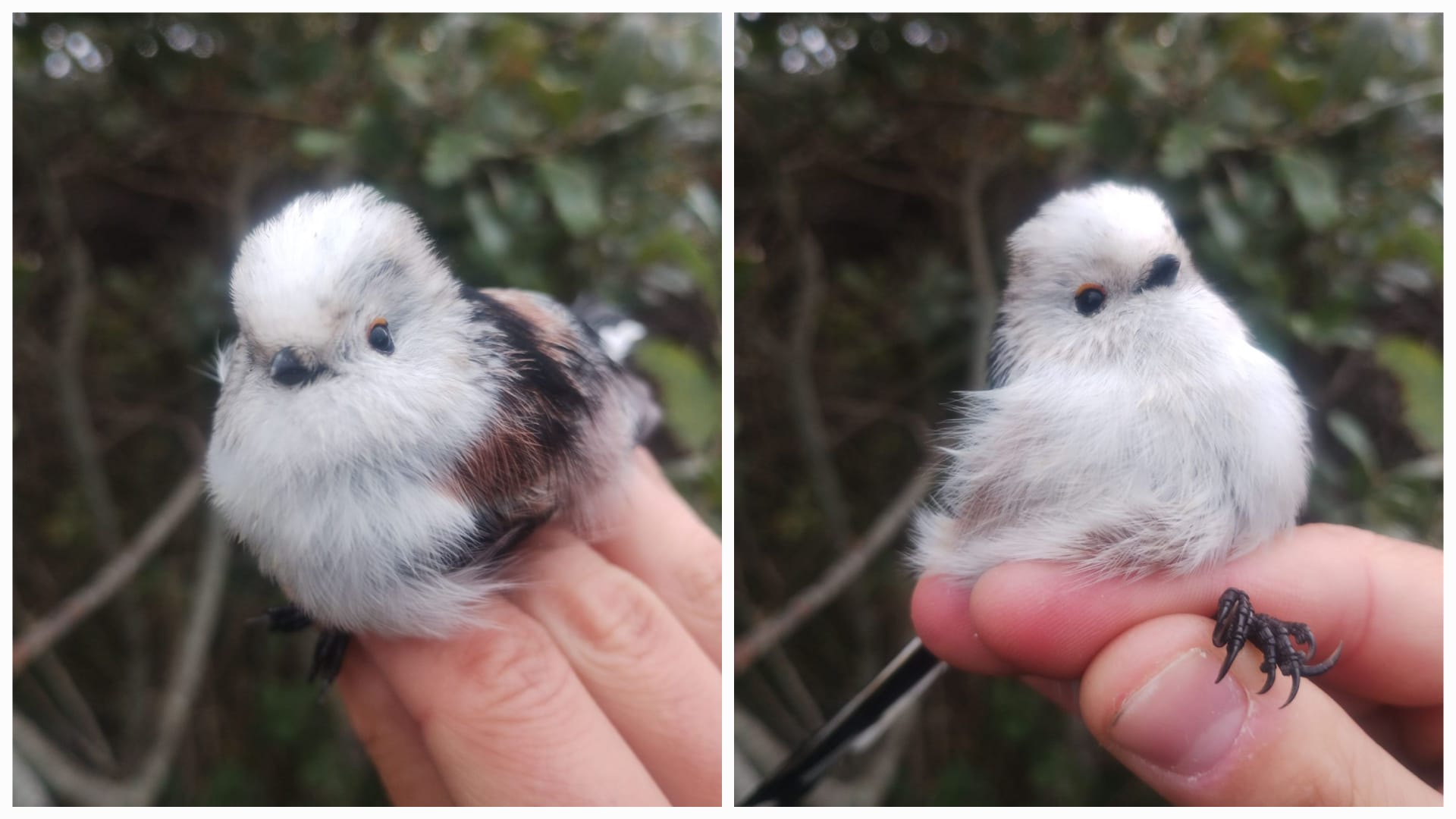
Then we had a flock of 8 Coal Tits (Sortmejse), which was also very exciting. On other days we caught one at most. As we also had many Blue Tits (Blåmejse) and one Great Tit (Musvit), we were able to take a good look at those different species.
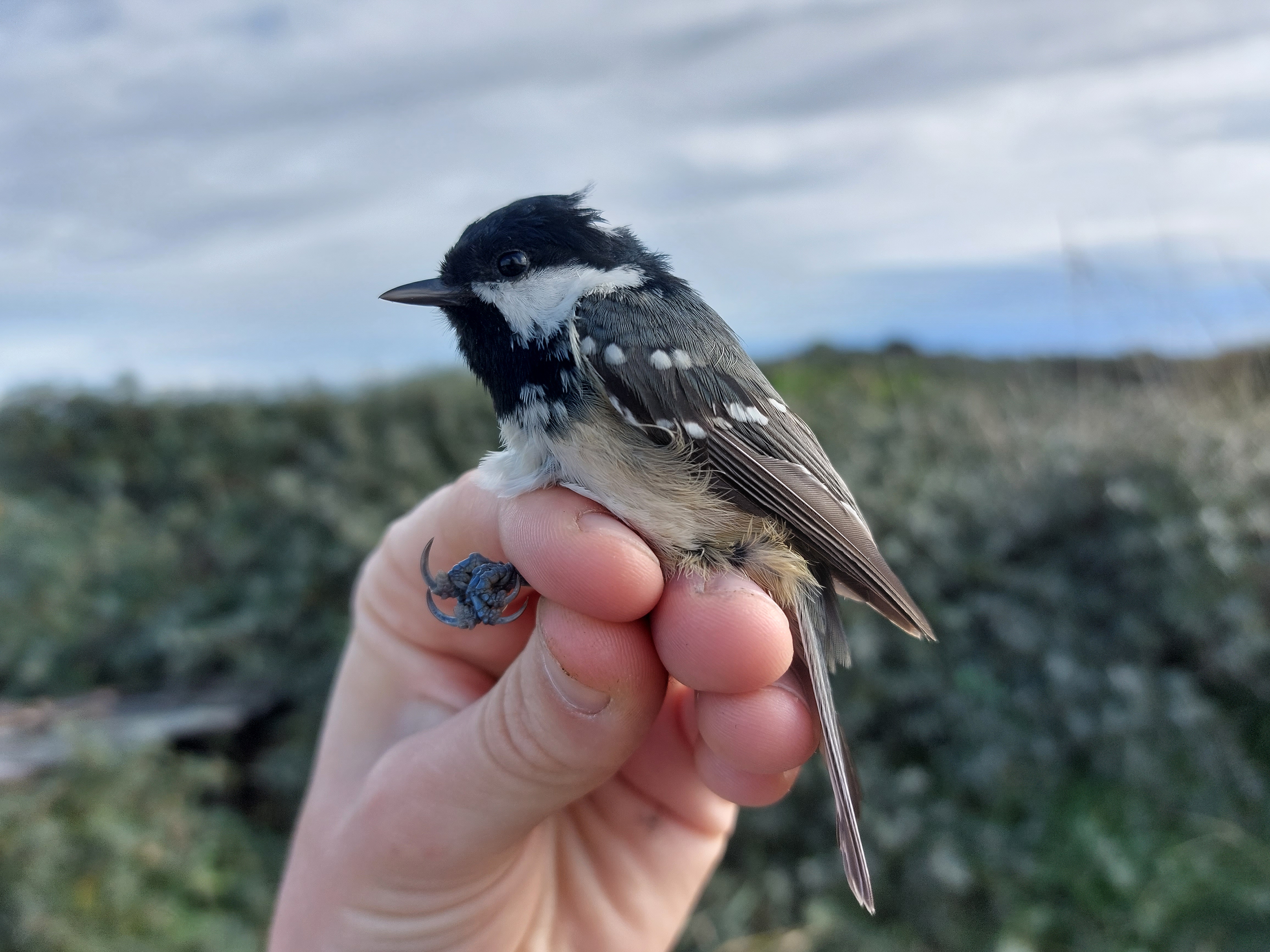
Even though we see many Wheatears (Stenpikker) on our daily walks around the area, we rarely catch them. That’s why it was a nice surprise today that we could ring this pretty bird and have a close-up look. And having a Great Spotted Woodpecker (Stor Flagspætte) and some Lesser Redpolls (Lille Gråsisken) is always an interesting sight.
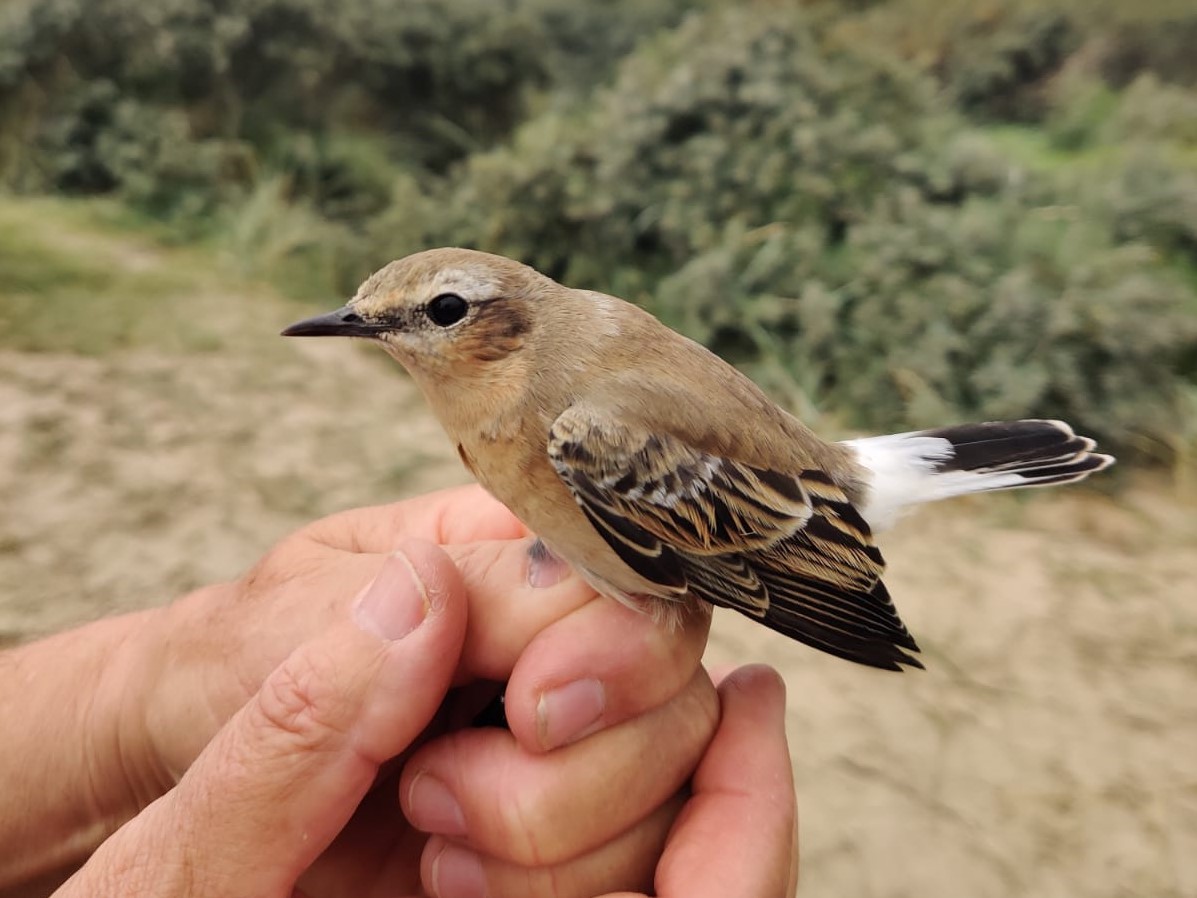
When we closed the nets at half past 1 pm, we had a total of 102 birds ringed. Since I have been here, this was by far the highest number per day. To see and measure many birds of different species really helps to develop a good eye for the molt limits and quickly decide about age or sex of the birds.
While the ringing day was really intense, Rebecca had a more quiet day at Migration Count with Knud this morning. Nevertheless, some Black Guillemots (Tejst) and Razorbills (Alk) were seen, and a nice group of waders, consisting of Dunlins (Almindelig Ryle), Red Knots (Islandsk Ryle), Ruffs (Brushane) and, Rebecca’s Highlight, Golden Plovers (Hjejle).
After this exciting day, we had to enter a lot of data, but still found time for walks around the beach, forest and dunes. Today, an very interesting phylloscopus Warbler was seen and heard at World’s End 1, and Simon Jr. even managed to hear the call in the evening. After checking of the sound files it seems to be a Hume's Leaf Warbler, which would be a very early one and not as called out first a Greenish Warbler (Lundsanger). But the ID is not clear, so we will keep you updated. Maybe we will catch it tomorrow.
Ringing (Kabeltromlekrattet):
Chiffchaff (Gransanger) – 11
Goldcrest (Fuglekonge) – 8
Longtailed Tit (Halemejse) - 3
Longtailed Tit (Halemejse, Sydlig; ssp. Europaeus) – 5
Dunnock (Jernspurv) – 9
Common Redstart (Rødstjert) – 3
Robin (Rødhals) – 23
Lesser Redpoll (Lille Gråsisken) – 2
Wren (Gærdesmutte) – 1
Reed Warbler (Rørsanger) – 1
Willow Warbler (Løvsanger) – 2
Coal Tit (Sortmejse) – 8
Black Cap (Munk) – 10
Blue Tit (Blåmejse) – 11
Wheatear (Stenpikker) – 1
Reed Bunting (Rørspurv) – 2
Great Tit (Musvit) – 1
Great Spotted Woodpecker (Stor Flagspætte) - 1
Total: 102
Ringing (Jennes Sø):
Wren (Gærdesmutte) – 1
Robin (Rødhals) - 5
Blackbird (Solsort) - 1
Blackbird (Munk) - 2
Chiffchaff (Gransanger) - 6
Goldcrest (Fuglekonge) - 1
Pied Flycatcher (Broget Fluesnapper) - 1
Great Tit (Musvit) - 4
Siskin (Grønsisken) - 2
Lesser Redpoll (Lille Gråsisken) - 116
Total: 139
People: Antonia Greil, Hayley Land, Rebecca Cheape, Gustav Nyberg, Simon Kiesé, Oluf Lou, Knud Pedersen, Michael Anchor, Jette and Anders.
A link to today's observations from volunteers and local observers.
